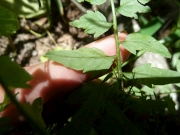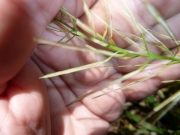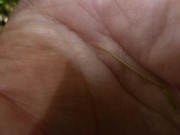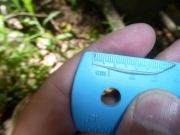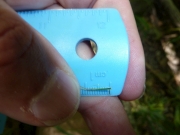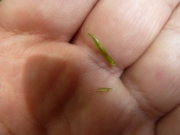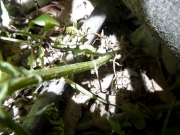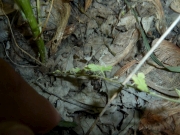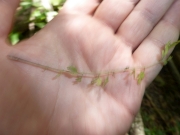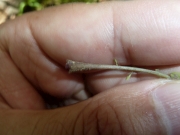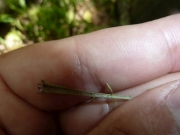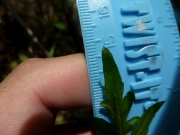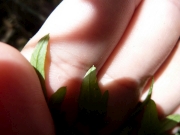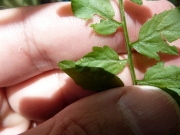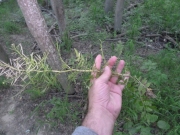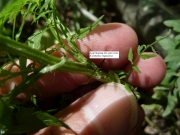Transformational Gardening
June 2012 Foraging Experiences
(Back to:
May 2012 Foraging Experiences)
(Forward to:
July 2012 Foraging Experiences)
June 1, 2012
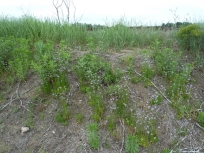
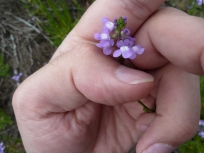 I thought that this plant was Texas Toadflax (Nuttallanthus texanus) even
though it is not supposed to grow here. The flowers and stem are so much bigger
than the Canada Toadflax that is so common around here.
I thought that this plant was Texas Toadflax (Nuttallanthus texanus) even
though it is not supposed to grow here. The flowers and stem are so much bigger
than the Canada Toadflax that is so common around here.
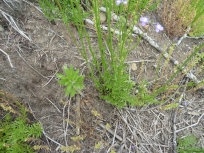
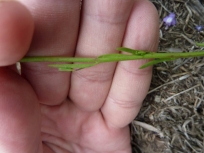 Fortunately, Research Botanist, Arthur Haines was kind enough to take some
of these plants and examine them (the size and the seeds). I tried to examine
the seeds myself, but I did not have great enough magnification to tell if
the seeds were tuberculate (bearing swellings or projections). It turns out
that this plant is simply Canada Toadflax with larger than typical flowers.
Fortunately, Research Botanist, Arthur Haines was kind enough to take some
of these plants and examine them (the size and the seeds). I tried to examine
the seeds myself, but I did not have great enough magnification to tell if
the seeds were tuberculate (bearing swellings or projections). It turns out
that this plant is simply Canada Toadflax with larger than typical flowers.
June 3, 2012
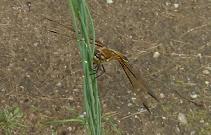
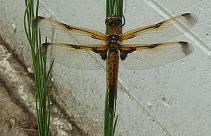 Dragonfly on sucking on Tower Mustard (Turritis glabra) seedpods.
Dragonfly on sucking on Tower Mustard (Turritis glabra) seedpods.
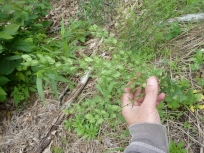
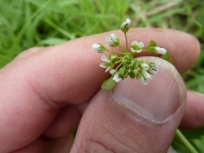 The seed pods on Field Pennycress are many times bigger than the similar-shaped
pods on Field Pepperweed (Lepidium campestre) and Virginia Pepperweed
(Lepidium virginicum). After I keyed out this plant for identification,
I was still left with several possible mustard genuses. I went through those
possibilities to be sure that I had the correct ID. It would have been easier
had I counted the number of seeds in the seed pods.
The seed pods on Field Pennycress are many times bigger than the similar-shaped
pods on Field Pepperweed (Lepidium campestre) and Virginia Pepperweed
(Lepidium virginicum). After I keyed out this plant for identification,
I was still left with several possible mustard genuses. I went through those
possibilities to be sure that I had the correct ID. It would have been easier
had I counted the number of seeds in the seed pods.
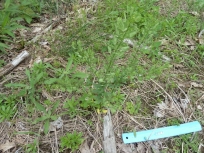
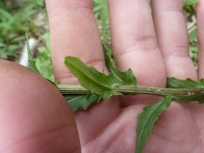
- Fruit is a silicle (up to 3 times as long as wide).
- Silicle not inflated.
- Silicle compressed at right angles to the septum. (By the way, I can’s
believe I even know what the words “silicle” and “septum” mean!)
- Leaves not confined to the base of the plant.
- Silicle with four seeds. I did not know this, so I had to key out the genus:
Lepidium and Iberis to confirm that it did not have 2 seeds.
- Flower petals all of similar size.
- Silicle is oval.
Wild Radish (Raphanus raphanistrum)
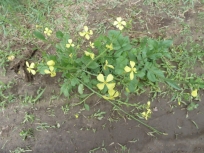
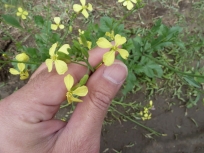 In order to separate the Wild Radish from the Cultivated Radish (Raphanus sativus),
it would have been helpful to take pictures of the seedpod, measure the width and notice
the long pointy seedpod beak. But I was too busy nibbling on radish root (which was a
little bit woody at this point). The taproot of Wild Radish is slender (not pictured)
while the taproot of Cultivated Radish and conspicuously thickened.
In order to separate the Wild Radish from the Cultivated Radish (Raphanus sativus),
it would have been helpful to take pictures of the seedpod, measure the width and notice
the long pointy seedpod beak. But I was too busy nibbling on radish root (which was a
little bit woody at this point). The taproot of Wild Radish is slender (not pictured)
while the taproot of Cultivated Radish and conspicuously thickened.
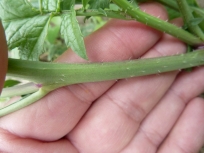
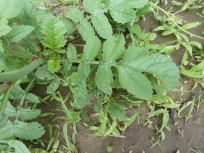
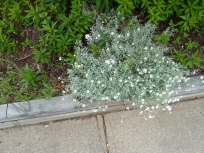
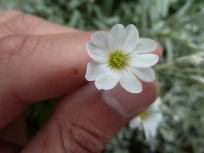 I think this was planted along with a bunch of other New England species. I decided
that I have to accept some plants in addition to what happens to be in the wild.
Otherwise, I may not have another opportunity to learn this species of Chickweed.
Fortunately, this is the only Chickweed in New England that is tomentose (a covering
of matted or tangled, soft, wooly hairs) so that the actual stems and leaves are almost
completed covered in hair.
I think this was planted along with a bunch of other New England species. I decided
that I have to accept some plants in addition to what happens to be in the wild.
Otherwise, I may not have another opportunity to learn this species of Chickweed.
Fortunately, this is the only Chickweed in New England that is tomentose (a covering
of matted or tangled, soft, wooly hairs) so that the actual stems and leaves are almost
completed covered in hair.
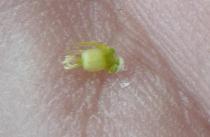
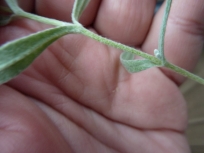
June 5, 2012
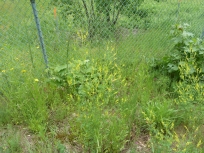
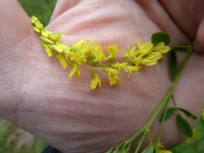 I recognized the pea flowers right away and went to the Fabaceae (Pea Family) key
to find out the genus of this plant. Fortunately, I was able to skip over much
of the Fabaceae key due to this plant having leaves with three leaflets that are
toothed.
I recognized the pea flowers right away and went to the Fabaceae (Pea Family) key
to find out the genus of this plant. Fortunately, I was able to skip over much
of the Fabaceae key due to this plant having leaves with three leaflets that are
toothed.
- Leaf blades compound.
- Leaf blades palmately compound or with 3 or fewer leaflets.
- Plants herbaceous or sub-woody.
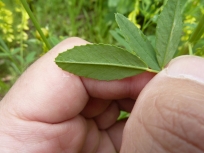
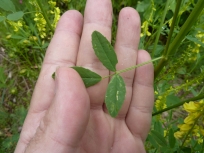
- Leaves pinnately or palmately compound with 3 or fewer leaflets.
- Leaflets toothed, at least minutely in the apical portion.
- Stipules entire (untoothed) and 1-nerved (1 vein). (Melilotus genus)
- Corollas yellow or white 4-7 mm long. Inflorescence 3-12 cm long.
- Corolla yellow, 5-7 mm long.
June 6, 2012
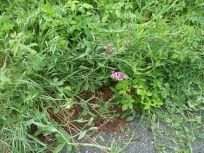
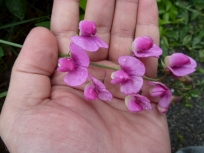 I have been trying to figure out this plant since last year. I can recognize pea
family flowers more easily, so I just had to figure out the genus and species:
I have been trying to figure out this plant since last year. I can recognize pea
family flowers more easily, so I just had to figure out the genus and species:
- Leaf blades compound.
- Leave palmately compound or with 3 or fewer leaflets.
- Plants herbaceous or sub-woody.
- Leaves pinnately or palmately compound with 3 or fewer leaflets.
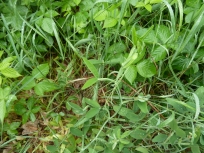
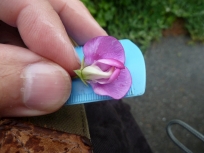
- Leaflets untoothed (entire).
- Leaflets even-pinnate (terminal leaflet modified into a tendril).
(Lathyrus genus)
- Leaves with 2 or more well-developed leaflets.
- Leaves with 2 leaflets.
- Inflorescence with 4-10 flowers. Plants perennial with rhizomes.
- Corollas 14-25 mm long, stems conspicuously winged.
- Stipules 3-10 mm wide and lanceolate to ovate. Corollas 13-20 mm long.
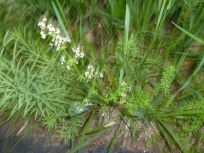
 I thought I found this plant last May, but there was no easy way at that time
to differentiate Whorled Bedstraw (Galium mollugo) from White Bedstraw
(Galium album). So, I am replacing those pictures with these which are
definately Galium mollugo.
I thought I found this plant last May, but there was no easy way at that time
to differentiate Whorled Bedstraw (Galium mollugo) from White Bedstraw
(Galium album). So, I am replacing those pictures with these which are
definately Galium mollugo.
- Main branches with 5-12 leaves at each node.
- Leaf blades sharply pointed to cuspidate at the apex.
- Corolla 1-7 mm in diameter.
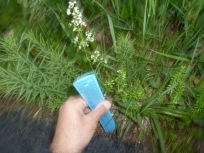
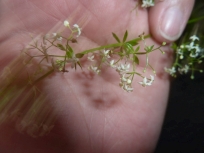
- Pedicels erect to spreading.
- Stems not rough to touch.
- Corolla not funnelform.
- Leaf blades linear to elliptic, 2-10 mm wide.
- Leaf blades 10-25 mm long.
- Corolla 2-3 mm. Pedicel usually longer than the diameter of the flower.
(Note: Galium album has 3-5 mm flower and pedicels shorter than diameter
of the flower.)
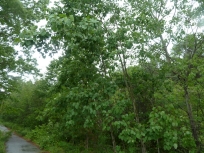
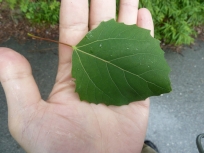 I identified another tree! Fortunately, the leaf shape is very distinctive. The buds
are supposed to be hairy, but I only found a few stray hairs on each of the buds.
I identified another tree! Fortunately, the leaf shape is very distinctive. The buds
are supposed to be hairy, but I only found a few stray hairs on each of the buds.
The Populus genus consists of various species of Balsam Poplars, Cottonwoods
and Aspens. The leaves are alternate. In most species, the leaves are twice as long
as wide, tip pointed, single-toothed and veins branching irregularly near the margin.
The flowers are catkins.

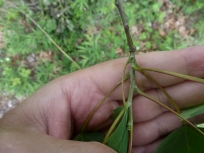
June 9, 2012
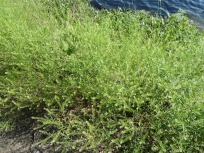
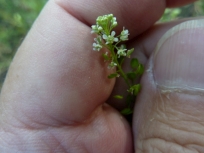 I really love the taste of the tops of Virginia Pepperweed. Mustard-like, tangy taste.
There were hundreds upon hundreds of plants. I could gather the flower tops, dry and
grind them into a powder to spice up dishes! Hiked and snacked on Virginia Papperweed,
Canada Lettuce, Hoary Allysum, Tower Mustard, and Indian Cucumber.
I really love the taste of the tops of Virginia Pepperweed. Mustard-like, tangy taste.
There were hundreds upon hundreds of plants. I could gather the flower tops, dry and
grind them into a powder to spice up dishes! Hiked and snacked on Virginia Papperweed,
Canada Lettuce, Hoary Allysum, Tower Mustard, and Indian Cucumber.
The most obvious difference between this plant and Field Pepperweed is that the leaves
of Virginia Pepperweed do not clasp the stem. Key:
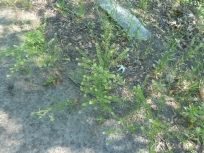
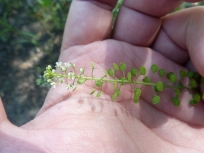
- Silicle (seed pod) surface smooth.
- Silicle with notch at the top.
- Stem leaves narrowed at base and not surrounding the stem.
- Silicles 2-4 mm long. Flowers with 2-4 stamen.
- Flower petals 1-2 times as long as the sepals.
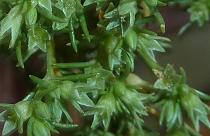
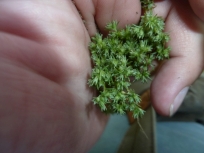 Big patches of this plant was growing in the dirt (near grass). It grew tangled and
very low to the ground. I didn't get any pictures at that location, but picked some
and took pictures while holding it on the final leg of my hike. I didn't realize,
but there is an Annual Knawel (this plant) and a Perennial Knawel
(Scleranthus perennis). The Perennial Knawel has sepals that are obtouse to
rounded at the apex and the floral bracts are mostly shorter than the flowers.
The Annual Knawel has acute-tipped sepals and bracts equaling or exceeding the
flowers.
Big patches of this plant was growing in the dirt (near grass). It grew tangled and
very low to the ground. I didn't get any pictures at that location, but picked some
and took pictures while holding it on the final leg of my hike. I didn't realize,
but there is an Annual Knawel (this plant) and a Perennial Knawel
(Scleranthus perennis). The Perennial Knawel has sepals that are obtouse to
rounded at the apex and the floral bracts are mostly shorter than the flowers.
The Annual Knawel has acute-tipped sepals and bracts equaling or exceeding the
flowers.
June 10, 2012
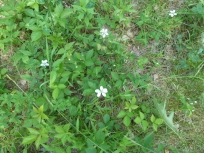
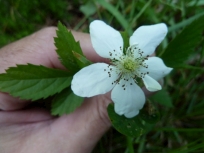 This is my third Rubus species identification. There are a total of 28 species
in New England. Key:
This is my third Rubus species identification. There are a total of 28 species
in New England. Key:
- Principal leaves compound. Plants usually armed with prickles or stiff bristles.
- Leaves with 3 pinnately arranged or 5 palmately arranged leaflets. Mature
fruit is black.
- Inflorescence a raceme or solitary flower (not a panicle).
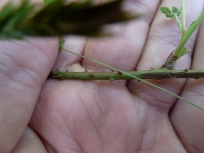
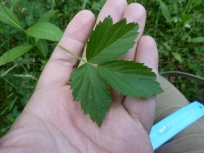
- First year vegetative stem (primocane) prostrate, dome-shaped. Trailing and
often rooting at the tip. Primocane not arching or erect.
- Primocane armed with broad-based prickles. Flower petals 10-25 mm long.
- Pedicels 10-60(-80) mm long, uppermost pedicel 10-20 mm long. Pedicels erect.
Inflorescence of 1-4 flowers. Pictures show the lower pedicels to be at least 50 mm
long.
- Stems thicker, 1.5-4 mm wide.
- Leaf blades hairless on the back except for the midvein and primary lateral veins.
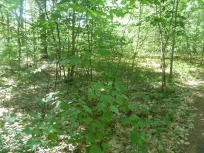
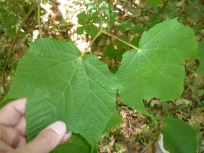 This is commonly seen as a very young tree in the forest. But this one was a bit
older so I could be sure that it grows into a full-sized maple tree. It has very
big leaves and each lobe comes to a sharp point. There are many small teeth in
between each lobe.
This is commonly seen as a very young tree in the forest. But this one was a bit
older so I could be sure that it grows into a full-sized maple tree. It has very
big leaves and each lobe comes to a sharp point. There are many small teeth in
between each lobe.
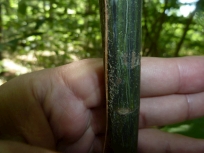
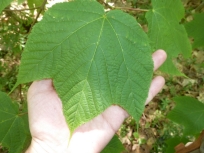
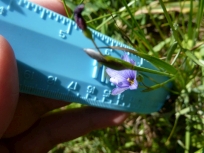
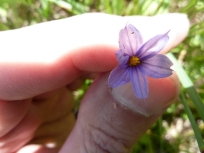 Last year I found a Blue-Eyed Grass and when I went back out to identify the species, the
rain had washed away all of the flowers. There are two important pieces of information
to determining the species: 1) the long bract (spathe) below the flower will either be
sessile or borne on a flower stem (peduncle). If it is borne on a flower stem, there will
usually be 2-5 peduncles per stem; 2) The stems will either have obvious winged margins
or barely-discernable wingled margins.
Last year I found a Blue-Eyed Grass and when I went back out to identify the species, the
rain had washed away all of the flowers. There are two important pieces of information
to determining the species: 1) the long bract (spathe) below the flower will either be
sessile or borne on a flower stem (peduncle). If it is borne on a flower stem, there will
usually be 2-5 peduncles per stem; 2) The stems will either have obvious winged margins
or barely-discernable wingled margins.
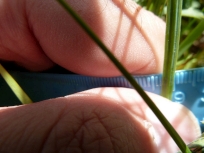
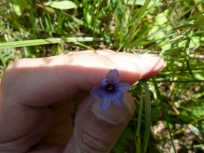 Key:
Key:
- Inflorescences occurring either singly or numbering 2-5 and borne on peduncles.
- Inflorescences numbering 2-5 and borne on peduncles.
- Stem 2.3-5 mm wide and broadly-winged.
June 11, 2012
Happy fern day! I already identified Cinnamon Fern (Osmunda cinnamomea)
and Sensitive Fern (Onoclea sensibilis). The three very common ferns
below means I know 5 out of 68 New England fern species. Before the ferns, below
is a friendly encounter with a porcupine on the trail:
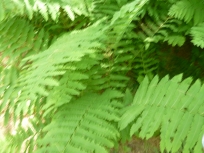
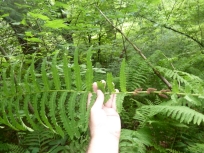 I love ferns (and plants) that are easy to identify! Remember that
Cinnamon Fern (Osmunda cinnamomea) has a separate fertile frond (leaf) with
cinnamon-colored spore-bearing leaflets completely covering the leaf blade. In
the case of Interrupted fern, the fertile fronds have regular leaflets that
are interrupted by several sets of dark brown spore-bearing leaflets. The slightly
shorter sterile fronds have no spore-bearing leaflets. The first picture to the
right shows a fertile frond with three sets of dark brown spore-bearing leaflets.
I love ferns (and plants) that are easy to identify! Remember that
Cinnamon Fern (Osmunda cinnamomea) has a separate fertile frond (leaf) with
cinnamon-colored spore-bearing leaflets completely covering the leaf blade. In
the case of Interrupted fern, the fertile fronds have regular leaflets that
are interrupted by several sets of dark brown spore-bearing leaflets. The slightly
shorter sterile fronds have no spore-bearing leaflets. The first picture to the
right shows a fertile frond with three sets of dark brown spore-bearing leaflets.
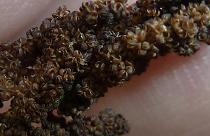
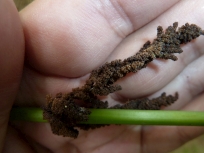 The fronds are large and grow in a circle. The leaf stalk (stipe) has tan wooly hairs.
The fiddleheads are stout with white to light tan wooly hairs. The leaves are bipinnate.
Royal Fern (Osmunda regalis) is similar to Interrupted Fern except the
spore-bearing leaflets are produced at the apex of the leaf blade.
The fronds are large and grow in a circle. The leaf stalk (stipe) has tan wooly hairs.
The fiddleheads are stout with white to light tan wooly hairs. The leaves are bipinnate.
Royal Fern (Osmunda regalis) is similar to Interrupted Fern except the
spore-bearing leaflets are produced at the apex of the leaf blade.
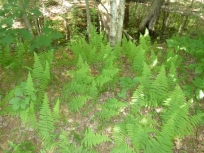
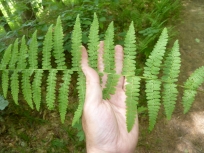 The smell from crushed Eastern Hay-Scented Fern is supposed to be like freshly cut hay,
but I do not remember what that smell is like. This plant (when crushed) smells a
little like Sweet Fern (Comptonia peregrina). Keys to identifying this fern:
The smell from crushed Eastern Hay-Scented Fern is supposed to be like freshly cut hay,
but I do not remember what that smell is like. This plant (when crushed) smells a
little like Sweet Fern (Comptonia peregrina). Keys to identifying this fern:
- Yellowish-green fern that grows singly from creeping rhizomes.
- Narrow, lance-shaped blades (<25 cm wide) with a relaxed and narrowly-pointed tip.
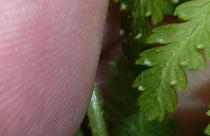
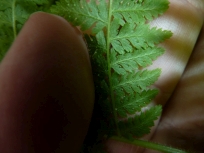
- Sori are small, cup-shaped (hard to see) and grow along the margin of the pinnules
(usually near the tooth sinuses).
- The leaves are bipinnate-pinnatafid
- Hairs on the stipe, rachis and leaflet blades. (Note: Northern Lady Fern
(Athyrium angustum) has brown to black scales on the stipe rather than hairs.)
Eastern Hay-Scented Fern can sometimes dominate large patches of the forest
understory.
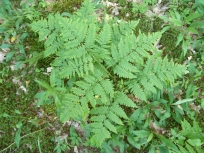
 This is supposed to be the only large fern (up to 3 ft. tall) in New England
where the blade is divided into three segments. The two basal pinnae are
relatively large. The blade is often held parallel to the ground. The stipe is
smooth and grooved. Sori are silvery at first, turning brown later in the year. The
sori are often covered or partially covered by the reflexed margins of the pinnules.
This is supposed to be the only large fern (up to 3 ft. tall) in New England
where the blade is divided into three segments. The two basal pinnae are
relatively large. The blade is often held parallel to the ground. The stipe is
smooth and grooved. Sori are silvery at first, turning brown later in the year. The
sori are often covered or partially covered by the reflexed margins of the pinnules.
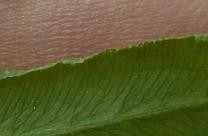
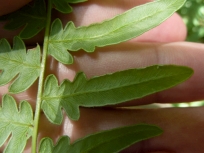 Key:
Key:
- Sporangium with well-developed annulus forming a complete or near complete ring.
Usually bearing 16-64 spores only.
- Sori located at the leaf margin.
- Petiole not appearing to fork into 2 divisions. (Family: Dennstaedtiaceae)
- Sori not borne in cup-like structures. Leaf blades wide (40-70 cm). (Genus/Species:
Pteridium aquilinum)
- Terminal segment of leaflets 2-4 times as long as wide.
(Subspecies: latiusculum)
June 12, 2012
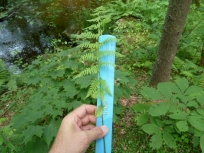
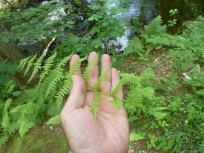 This was my first difficult fern as far as the ID. The important thing to look for
is the sori are long and almost straight, but often with a slight curve. The fronds
grow in circular clusters and have a relaxed (hanging down) tip. The stipe is smooth
with scattered brown scales. Base of stipe dark red-brown and swollen. Blade widest
in the middle.
This was my first difficult fern as far as the ID. The important thing to look for
is the sori are long and almost straight, but often with a slight curve. The fronds
grow in circular clusters and have a relaxed (hanging down) tip. The stipe is smooth
with scattered brown scales. Base of stipe dark red-brown and swollen. Blade widest
in the middle.
Key:
- Sporangium with well-developed annulus forming a complete or near complete ring.
Usually bearing 16-64 spores only.
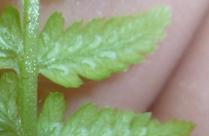
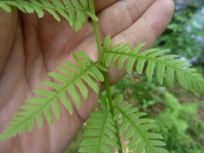
- Sori not located at the margin.
- Leaves not evergreen nor once-pinnate.
- Sori not immediately adjacent to the costa, but adjacent to the veinlets.
- Scales on the stem not lattice-like.
- Plants without needle-like, unicellular, transparent hairs.
- Leaves monomorphic or weakly dimorphic
- Veins reaching margin of leaf segments.
- Indusium broad linear, hooked or horseshoe-shaped. (Family: Woodsiaceae)
- Basal leaflets not noticably larger than the adjacent pair.
- Indusium linear, hooked at one end or horseshoe-shaped (not short and inconspicuous).
(Genus: Athyrium)
- Leaf blade green (not varigated or suffused with gray to silver).
- Leaf blade elliptical, broadest at or just below the middle. Petiole scales
black-brown.
June 19, 2012
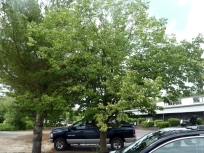
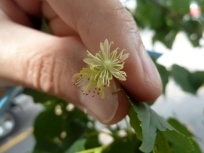 After a couple of years of hoping to find this tree, I found it. Actually, someone else
pointed it out to me. Hopefully, I can find many more and be ready for Springtime leaf
snacks. A few things I want to remember include:
After a couple of years of hoping to find this tree, I found it. Actually, someone else
pointed it out to me. Hopefully, I can find many more and be ready for Springtime leaf
snacks. A few things I want to remember include:
- Trunk is straight and the form is a symmetrical, rounded crown.
- Branches spreading and ascending.
- Commonly found with American Beech, White Ash and Red Oak. Often on moist slopes
that face north and/or east.
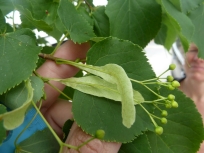
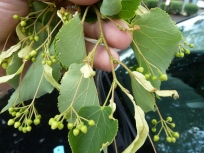
- Leaves are slightly heart-shaped. Translucent when young. Dull green above, lighter
beneath. Sharply acuminate tip.
- Cream yellow flowers appear in June or July.
Key:
- Leaf blades 7-20 cm long.
- Petioles less than 50% as long as the blade. (Tilia americana)
- Back of leaf blade not pubescent with stellate hairs. (Variation: americana)
June 20, 2012
Shrubby Cinquefoil (Dasiphora floribunda)
(Also known as: Pentaphylloides floribunda)
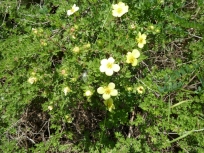
 When I saw the flowers, I immediately thought of cinquefoil flowers. But the leaves looked
so much different. So, I went through the key of the Rosaceae family to discover that it
was the Dasiphora genus. Key:
When I saw the flowers, I immediately thought of cinquefoil flowers. But the leaves looked
so much different. So, I went through the key of the Rosaceae family to discover that it
was the Dasiphora genus. Key:
- Leaf blades compound.
- Leaf blades once- or twice-pinnately compound, always with more than 3 leaflets.
- Plants woody.
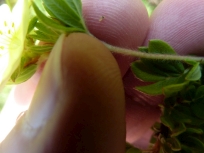
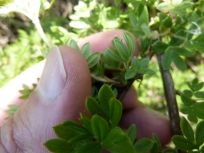
- Inflorescence with fewer than 25 flowers. Flowers with many carpels.
- Plants unarmed (no bristles or prickles). Leaf margin untoothed (entire).
June 21, 2012
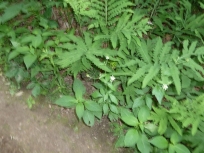
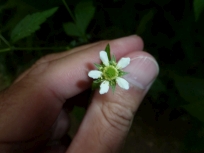 I saw this plant last year and thought it might be an Aster. But few Asters are in bloom
now. Fortunately, the leaves with three toothed leaflets below and simple leaves above
helped me identify this plant.
I saw this plant last year and thought it might be an Aster. But few Asters are in bloom
now. Fortunately, the leaves with three toothed leaflets below and simple leaves above
helped me identify this plant.
Infusion or decoction of the cut or powdered root is used to treat
fevers, flu, chills, diarrhea, weakness and asthmatic symptoms.
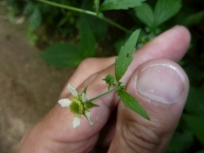
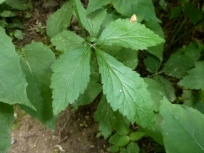 Key:
Key:
- Flowering stems with evident, well-developed leaves.
- Flower petals 2-10 mm long.
- Sepals green, reflexed (bent down) at time of flowering.
- Petals white to yellow-white.
- Basal leaf blades with 3 principal leaflets. Pedicels mostly thinner than 1 mm.
- Petals white, 4-9 mm long.
June 22, 2012
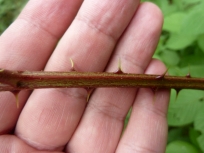
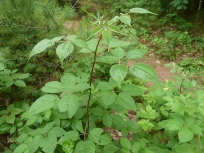 I’ve seen a lot of Blackberry bushes lately, but they don’t always have
flowers or blackberries growing, so they have been difficult to identify. This one
has both blackberries (still green) and flower remnants. Some of the important things
to look for are straightish spines on the primocane, stipitate glands or gland-tipped
hairs on the peduncle, raceme inflorescence longer than 8 mm. Key:
I’ve seen a lot of Blackberry bushes lately, but they don’t always have
flowers or blackberries growing, so they have been difficult to identify. This one
has both blackberries (still green) and flower remnants. Some of the important things
to look for are straightish spines on the primocane, stipitate glands or gland-tipped
hairs on the peduncle, raceme inflorescence longer than 8 mm. Key:
- Principal leaves compound.
- Stems woody. Clearly differentiated into primocanes and floricanes.
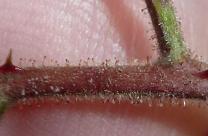
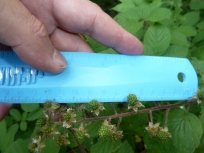
- 5 palmately arranged leaflets.
- Inflorescence a raceme.
- Primocanes arching to erect.
- Primocanes armed with at least some stout, broad-based prickles.
- Inflorescence with stipitate glands.
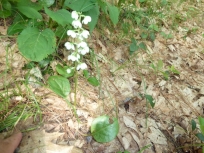
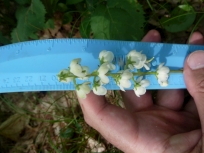 This was an unexpected encounter. After several years of walking along trails, I have
only seen a Shinleaf one other time. It was right at the edge of the trail in a fairly
dry location amongst American Beech trees. Key:
This was an unexpected encounter. After several years of walking along trails, I have
only seen a Shinleaf one other time. It was right at the edge of the trail in a fairly
dry location amongst American Beech trees. Key:
- Style elongate and strongly down-curved.
- Leaf blades 25-70 mm long.
- Leaf blades broad-elliptic to reniform usually +- equaling the length of the petiole.
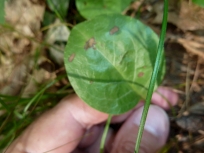
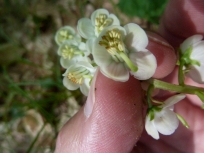
- Petals white (not pink).
Maleberry (Lyonia ligustrina) (Also known as: Lyonia ligustrina var. ligustrina)
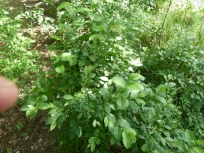
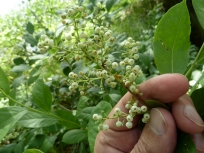 I wonder why this is named, “Maleberry.” Finding out sounds like a good Winter project.
It is important to remember to take pictures of the brown five-parted seed capsules as it is a
tell-tale sign of Maleberry (See the picture in the second row on the left.) A few things about
this plant to notice:
I wonder why this is named, “Maleberry.” Finding out sounds like a good Winter project.
It is important to remember to take pictures of the brown five-parted seed capsules as it is a
tell-tale sign of Maleberry (See the picture in the second row on the left.) A few things about
this plant to notice:
- Grows near marshes.
- Flowers grow in raceme-like inflorescence from the leaf axils.
- Brown, five-parted seed capsules.
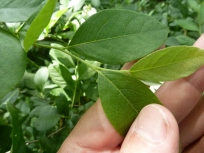
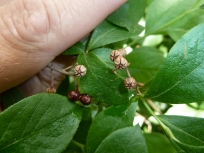
- Alternate leaves.
- Orange-gold tinge to the bark on the woody stem.
Royal Fern (American Royal Fern)
(Osmunda regalis) Also known as: Osmunda regalis var. spectabilis)
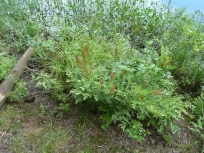
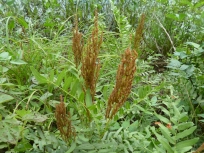 This fern is similar to Cinnamon Fern (Osmunda cinnamomea) and Interrupted Fern
(Osmunda claytoniana). Cinnamon Fern has a complete separate cinnamon-colored
stalk of spores. Interrupted Fern has fertile frond leaflets (pinnae) and then spores
in the middle followed by more leaflets. Royal fern has spores covering the tops of the
fertile frond. Another difference is the Royal Fern has much longer and wider-space
(alternating) pinnules (leafules). It is often found next to water.
This fern is similar to Cinnamon Fern (Osmunda cinnamomea) and Interrupted Fern
(Osmunda claytoniana). Cinnamon Fern has a complete separate cinnamon-colored
stalk of spores. Interrupted Fern has fertile frond leaflets (pinnae) and then spores
in the middle followed by more leaflets. Royal fern has spores covering the tops of the
fertile frond. Another difference is the Royal Fern has much longer and wider-space
(alternating) pinnules (leafules). It is often found next to water.
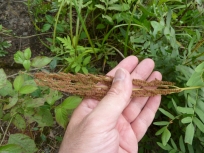
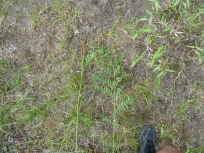
June 23, 2012
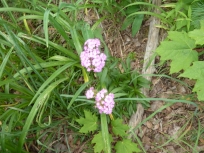
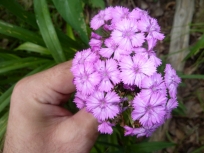 This plant may have escaped from a garden somewhere. It is easy to see that the flowers
look similar to Maiden Pink (Dianthus deltoides). Key:
This plant may have escaped from a garden somewhere. It is easy to see that the flowers
look similar to Maiden Pink (Dianthus deltoides). Key:
- Plants with closely crowded, sessile or short-pedicellate flowers (terminal cymes).
- Calyx complete glabrous (hairless) or sometimes only the lobes pubescent (hairy).
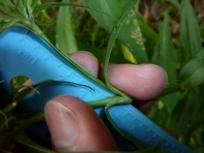
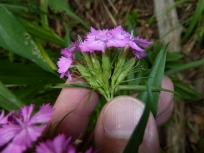
- Stem leaf blades lanceolate to oblanceolate (15-20 mm wide). Calyx lobes glabrous.
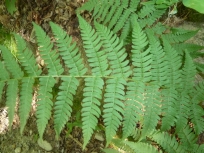
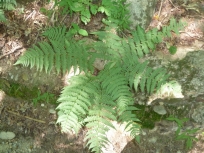 A few important tips for recognizing Marginal Wood Fern:
A few important tips for recognizing Marginal Wood Fern:
- Fronds (leaves) grow in a circular pattern (typical for Wood Ferns).
- Pinnules (leafules) on the lower side are longer than those on the upper side (typical for
Wood Ferns).
- Copper-colored scales on the stipe (stem) (typical for Wood Ferns).
- Large kidney-shaped sori grow along the margins.
- Pinnules (leafules) have a blunt tip.
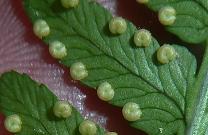
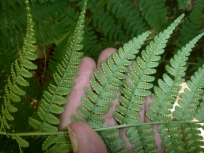
- Pinnae (leaflets) rapidly taper to a point.
- Withered fronds can sometimes be seen coming from the circle of living fronds.
June 24, 2012
Biennial Bee-Blossom (Oenothera gaura) (Also known as: Gaura biennis)
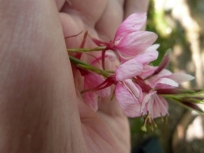
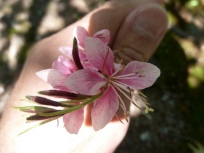 What an amazing find! Actually, Arthur Haines found this before it flowered while
he was teaching a class. When I was back in the area, I looked to see what it had turned
into. At first I wasn’t sure that it was a Evening Primrose genus (Oenothera),
so I went through the Onagraceae (Evening Primrose family) key:
What an amazing find! Actually, Arthur Haines found this before it flowered while
he was teaching a class. When I was back in the area, I looked to see what it had turned
into. At first I wasn’t sure that it was a Evening Primrose genus (Oenothera),
so I went through the Onagraceae (Evening Primrose family) key:
- Calyx and Corolla has 4 to 6 petals.
- 8 stamen.
- Flowers zygomorphic, the petals all oriented toward one side of
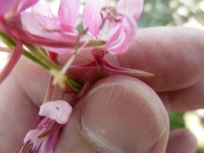
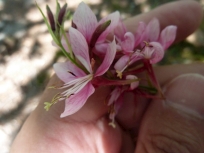 the flower. I was told by
Arthur Haines to also notice that the stamen in this case are oriented toward one side of the
flower. Genus: Oenothera
the flower. I was told by
Arthur Haines to also notice that the stamen in this case are oriented toward one side of the
flower. Genus: Oenothera
- Flowers zygomorphic.
- Petals 6-15 mm long. Anthers 1.5-5 mm long.
Once I was this far along in the key, I had to decide between Biennial Bee-Blossom (Oenothera
gaura) and Longflower Bee-Blossom (Oenothera filiformis, Gaura biennis var. pitcheri,
Guara longiflora). This was a very difficult task relying on my pictures only (since it is
a 2-1/2 drive to the flower). The stem and inflorescence of Biennial Bee-Blossom are densely
villous (long, soft, bent hairs, not tangled). The backs of the leaves are short-villous along
the margins. On the other hand, Longflower Bee-Blossom stems and inflorescence are densely
strigulose (tiny straight, stiff, sharp and appressed hairs). Looking at the closeup pictures
towards the bottom of the table below, I came to the conclusion that most of the hairs are
villous and therefore the plant is Biennial Bee-Blossom. It is a very rare plant in Eastern
New England.
June 26, 2012
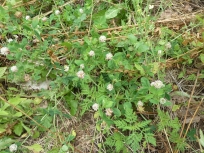
 Out of the 16 white, pink or purple Trifolium flowers in New England, only
White Clover and Alsike Clover (Trifolium hybridum) have flower pedicels
longer than 0.5 mm (usually 2 mm or longer). To differentiate these two plants:
Out of the 16 white, pink or purple Trifolium flowers in New England, only
White Clover and Alsike Clover (Trifolium hybridum) have flower pedicels
longer than 0.5 mm (usually 2 mm or longer). To differentiate these two plants:
- Alsike Clover grows more upright and does not root at the nodes. White Clover roots at
the nodes and is more spreading.
- Alsike Clover has flower petals of two different colors. White Clover has flower
petals usually all of a similar color.
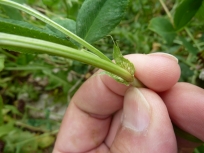
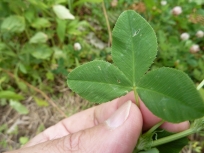
- Most of the end of the stipules for Alsike Clover are free from the stem. The end of the
stipules for White Clover wraps around the stem, forming a tube.
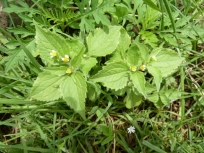
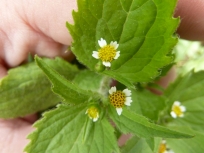 This is a common weed in the public gardens. It is extremely hairy and edible (cooked).
The easiest way to differentiate it from Lesser Quickweed (Galinsoga parviflora) is
that Lesser Quickweed is much less hairy. In addition, the pappus (modified calyx crowning the
ovary) of the disk flowers for Hairy Galinsoga has an awn (narrow bristle) tip. The pappus
of the ray flowers of Hairy Galinsoga is well-developed, but poorly-developed for
Lesser Quickweed.
This is a common weed in the public gardens. It is extremely hairy and edible (cooked).
The easiest way to differentiate it from Lesser Quickweed (Galinsoga parviflora) is
that Lesser Quickweed is much less hairy. In addition, the pappus (modified calyx crowning the
ovary) of the disk flowers for Hairy Galinsoga has an awn (narrow bristle) tip. The pappus
of the ray flowers of Hairy Galinsoga is well-developed, but poorly-developed for
Lesser Quickweed.
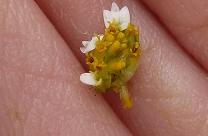
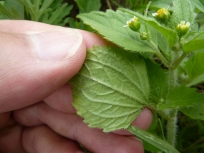
June 27, 2012
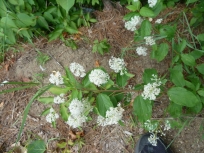
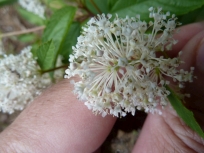 New Jersey Tea (Ceanothus americanus) is part of the Buckthorn (Rhamnaceae) family.
What distinguishes the Ceanothus genus from other Buckthorn genuses is that the leaf blade
has three prominent veins from near the base of the leaf and the inflorescense is a terminal umbrel
with numerous flowers. Prairie Redroot (Ceanothus herbaceus) is similar, but New Jersey Tea
has larger leaves and the veins emerge from 1-3 mm below the base of the leaf.
New Jersey Tea (Ceanothus americanus) is part of the Buckthorn (Rhamnaceae) family.
What distinguishes the Ceanothus genus from other Buckthorn genuses is that the leaf blade
has three prominent veins from near the base of the leaf and the inflorescense is a terminal umbrel
with numerous flowers. Prairie Redroot (Ceanothus herbaceus) is similar, but New Jersey Tea
has larger leaves and the veins emerge from 1-3 mm below the base of the leaf.
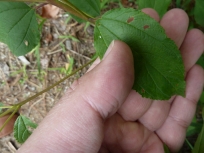
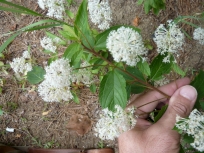
June 28, 2012
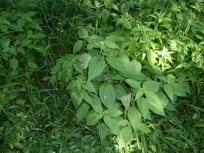
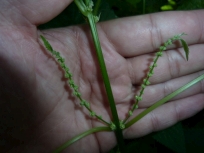 This is a fairly common plant. But I had avoided trying to identify it for years
because I never saw the flowers. There is only one species in the Boehmeria genus
(in New England). But there is another genus in the same family with very similar,
non-stinging plants: Pilea. The flowers of Small-Spike False Nettle are a spike,
while the flowers of Pilea species are a panicle. In addition, the cystoliths
(concentration of calcium carbonate appearing as minute segments on the leaf) are rounded
in Small-Spike False Nettle but linear in Pilea species.
This is a fairly common plant. But I had avoided trying to identify it for years
because I never saw the flowers. There is only one species in the Boehmeria genus
(in New England). But there is another genus in the same family with very similar,
non-stinging plants: Pilea. The flowers of Small-Spike False Nettle are a spike,
while the flowers of Pilea species are a panicle. In addition, the cystoliths
(concentration of calcium carbonate appearing as minute segments on the leaf) are rounded
in Small-Spike False Nettle but linear in Pilea species.

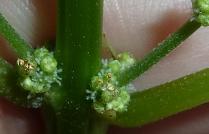
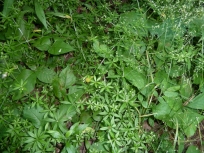
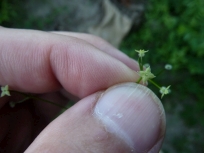 At first I thought this was White Bedstraw (Galium album). I didn’t
want to hang around for photos because the mosquitoes were swarming. Fortuntely,
I noticed that the stem was very sticky (and rough) feeling. I'll need to go back
and double-check, tough.
At first I thought this was White Bedstraw (Galium album). I didn’t
want to hang around for photos because the mosquitoes were swarming. Fortuntely,
I noticed that the stem was very sticky (and rough) feeling. I'll need to go back
and double-check, tough.
If the stem was not rough to the touch, I would have to decide between
White Bedstraw (Galium album), Wood Bedstraw (Galium sylvaticum) and
Whorled Bedstraw (Galium mollugo). All three of these have inflorescences
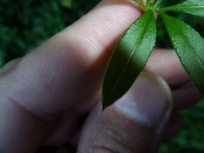
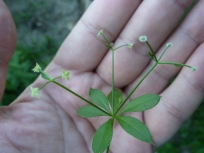 with 5-20 flowers. This plant seems to have inflorescences with 2-3 flowers. Key:
with 5-20 flowers. This plant seems to have inflorescences with 2-3 flowers. Key:
- Main branches with 5-12 leaves at each node.
- Leaf blades sharply pointed to cuspidate at the apex.
- Corolla 1-7 mm in diameter.
- Pedicels erect to spreading.
- Stems rough to the touch (scabrous) on the angles of the internodes.
Inflorescence with 2-5 flowers.
- Leaves (4-)6 per node.
- Schizocarps (fruit) uncinate-bristly (as opposed to glabrous). Leaf
blades 15-85 mm long and 4-13 mm wide. Leaves scabrous on the margin.
Corolla green-white.
June 29, 2012
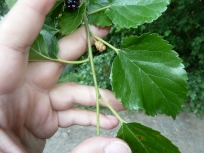
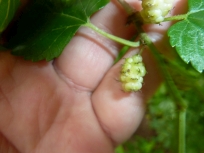 I had a hard time determining if this was White Mulberry (Morus alba)
or Red Mulberry (Morus rubra) since it seems to have some characteristics
of both. The front of the leaves were scabrous (rough to touch due to short,
stiff, appressed hairs) as found in Red Mulberry, but it was only slightly scabrouns
and slightly smooth. The front leaf surface was glossy as found in White Mulberry. The
back of the leaf had tufts of hairs along the major veins as found in White Mulberry.
I had a hard time determining if this was White Mulberry (Morus alba)
or Red Mulberry (Morus rubra) since it seems to have some characteristics
of both. The front of the leaves were scabrous (rough to touch due to short,
stiff, appressed hairs) as found in Red Mulberry, but it was only slightly scabrouns
and slightly smooth. The front leaf surface was glossy as found in White Mulberry. The
back of the leaf had tufts of hairs along the major veins as found in White Mulberry.
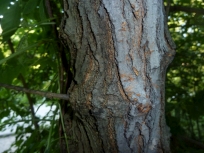
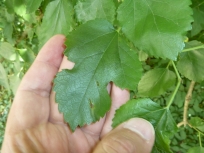 Some of the fruit was whitish as found in White Mulberry (although it will be interesting
to see if those whitish fruits turn purple. White Mulberry can have some fruits
that are pink, purple and even black. Finally, red Mulberry is found mostly in Western
New England while White Mulberry throughout New England.
Some of the fruit was whitish as found in White Mulberry (although it will be interesting
to see if those whitish fruits turn purple. White Mulberry can have some fruits
that are pink, purple and even black. Finally, red Mulberry is found mostly in Western
New England while White Mulberry throughout New England.
According to the Duke University
Red Mulberry web page, White Mulberry and Red Mulberry can often hybridize, resulting
in trees with intermediate characteristics. It is possible that this is a hybrid.
June 30, 2012
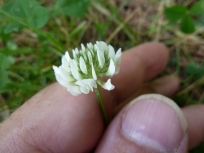
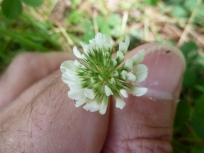 Out of the 16 white, pink or purple Trifolium flowers in New England, only
White Clover and Alsike Clover (Trifolium hybridum) have flower pedicels
longer than 0.5 mm (usually 2 mm or longer). To differentiate these two plants:
Out of the 16 white, pink or purple Trifolium flowers in New England, only
White Clover and Alsike Clover (Trifolium hybridum) have flower pedicels
longer than 0.5 mm (usually 2 mm or longer). To differentiate these two plants:
- White Clover roots at the nodes and is more spreading while Alsike Clover grows more
upright and does not root at the nodes.
- White Clover has flower petals usually all of a similar color. Alsike Clover has
flower petals of two different colors.
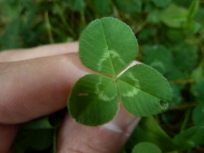
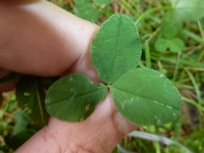
- The end of the stipules for White Clover wraps around the stem, forming a tube.
Most of the end of the stipules for Alsike Clover are free from the stem.
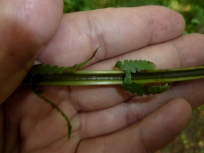
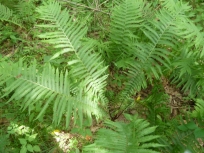 Finally! It took me forever to find this fern! But I'll be enjoying fiddleheads next
Spring. Here are a couple of key identifying features:
Finally! It took me forever to find this fern! But I'll be enjoying fiddleheads next
Spring. Here are a couple of key identifying features:
- Tall fronds (leaves).
- Lower leaflets get smaller going down the stem, so that the lowest leaflets are very
small.
- Sori is on a separate copper-brown fertile frond that is much smaller. It develops
in the Summer and remnants can be found in the Winter and
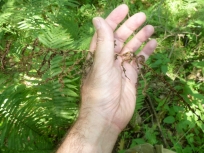
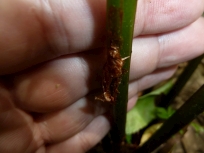 Spring. See pictures near the
bottom of the table for images of an dead fertile frond.
Spring. See pictures near the
bottom of the table for images of an dead fertile frond.
- Very large red-brown scales on the stipe (stem) and fiddlehead.
- Fronds grow in a circular pattern.
- Large and very deep grove in the stipe and fiddlehead stem.
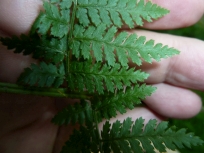
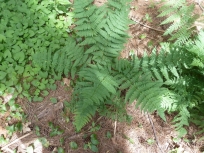 I found this fern in May 2011 in fiddlehead form, but I wasn't able to identify it.
A research botanist told me at the time that it was Evergreen Wood Fern. The is my
first real identification of the plant (at a new location). Here are a few things
to remember about Evergreen Wood Fern:
I found this fern in May 2011 in fiddlehead form, but I wasn't able to identify it.
A research botanist told me at the time that it was Evergreen Wood Fern. The is my
first real identification of the plant (at a new location). Here are a few things
to remember about Evergreen Wood Fern:
- Lower pinnules (leafules) are larger than the upper pinnules on the same pinna (leaflet).
- Veins do not reach the margin.
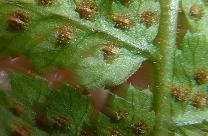
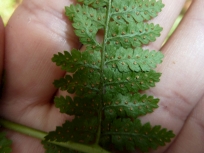
- Circular sori (collection of spores), not on the margins.
- Medium-sized brown/copper scales on the stipe (leaf stem).
- Bipinnate, pinnatifid (slightly lobed) leaves.
- Gland-tipped hairs on the costa (leaflet stem).
- On the lowest pinna (leaflet), the inner and bottom pinnule (leafule) is much smaller
than the adjacent pinnule (See picture on the right of the first row, above.)
- Leaves stay green through Winter, but die out in the Spring.
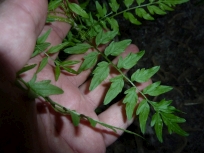
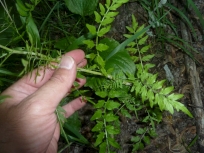 The silique seed pods were a give-away that this was in the Mustard family. It
has a very nice horseradish taste. Key:
The silique seed pods were a give-away that this was in the Mustard family. It
has a very nice horseradish taste. Key:
- Fruit a silique (greater than 3 times as long as wide).
- Silique longitudinally dehiscent (splits open along its length).
- Lower leaf blades lobed or divided.
- Principal leaf blades pinnately lobed or pinnately divided.
- Plants glaberous (hairless) or pubescent (hairy) with unbranched hairs.

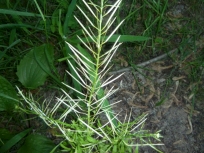
- Stem leaves sessile and auriculate-clasping.
- Septum (partition between the seeds) and replum (wing-like border of the septum)
perpendicular forming I-bean cross-section. (Cardamine genus)
- Principal leaf blades simple or pinnately lobed or pinnately divided.
- Lower leaf blades pinnately lobed (sinuses to nearly the midrib) or pinnately
divided. Upper leaf blades usually similar.
- Principal leaf blades with 5-17 leaflets.
- Stem leaves clasping the stem. Sharply-toothed or lacerate-margined (torn-looking)
leaflets.
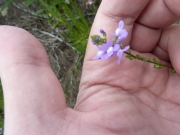
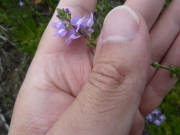
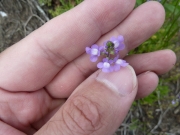
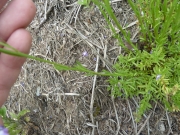
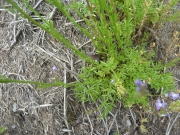
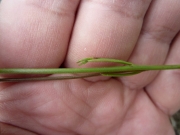
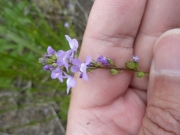
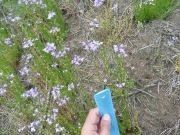
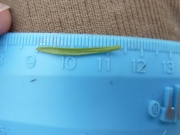
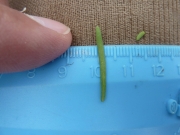
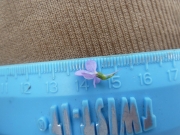
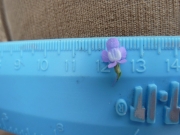


 I thought that this plant was Texas Toadflax (Nuttallanthus texanus) even
though it is not supposed to grow here. The flowers and stem are so much bigger
than the Canada Toadflax that is so common around here.
I thought that this plant was Texas Toadflax (Nuttallanthus texanus) even
though it is not supposed to grow here. The flowers and stem are so much bigger
than the Canada Toadflax that is so common around here.
 Fortunately, Research Botanist, Arthur Haines was kind enough to take some
of these plants and examine them (the size and the seeds). I tried to examine
the seeds myself, but I did not have great enough magnification to tell if
the seeds were tuberculate (bearing swellings or projections). It turns out
that this plant is simply Canada Toadflax with larger than typical flowers.
Fortunately, Research Botanist, Arthur Haines was kind enough to take some
of these plants and examine them (the size and the seeds). I tried to examine
the seeds myself, but I did not have great enough magnification to tell if
the seeds were tuberculate (bearing swellings or projections). It turns out
that this plant is simply Canada Toadflax with larger than typical flowers.













 Dragonfly on sucking on Tower Mustard (Turritis glabra) seedpods.
Dragonfly on sucking on Tower Mustard (Turritis glabra) seedpods.
 The seed pods on Field Pennycress are many times bigger than the similar-shaped
pods on Field Pepperweed (Lepidium campestre) and Virginia Pepperweed
(Lepidium virginicum). After I keyed out this plant for identification,
I was still left with several possible mustard genuses. I went through those
possibilities to be sure that I had the correct ID. It would have been easier
had I counted the number of seeds in the seed pods.
The seed pods on Field Pennycress are many times bigger than the similar-shaped
pods on Field Pepperweed (Lepidium campestre) and Virginia Pepperweed
(Lepidium virginicum). After I keyed out this plant for identification,
I was still left with several possible mustard genuses. I went through those
possibilities to be sure that I had the correct ID. It would have been easier
had I counted the number of seeds in the seed pods.

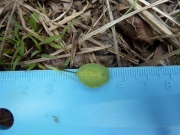
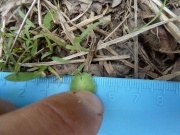
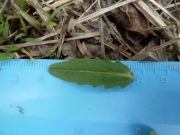
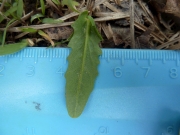
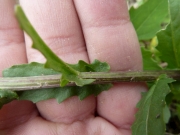
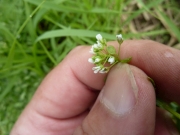

 In order to separate the Wild Radish from the Cultivated Radish (Raphanus sativus),
it would have been helpful to take pictures of the seedpod, measure the width and notice
the long pointy seedpod beak. But I was too busy nibbling on radish root (which was a
little bit woody at this point). The taproot of Wild Radish is slender (not pictured)
while the taproot of Cultivated Radish and conspicuously thickened.
In order to separate the Wild Radish from the Cultivated Radish (Raphanus sativus),
it would have been helpful to take pictures of the seedpod, measure the width and notice
the long pointy seedpod beak. But I was too busy nibbling on radish root (which was a
little bit woody at this point). The taproot of Wild Radish is slender (not pictured)
while the taproot of Cultivated Radish and conspicuously thickened.

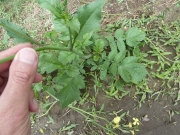
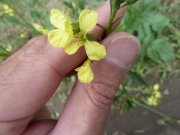
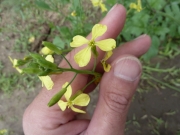
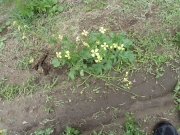

 I think this was planted along with a bunch of other New England species. I decided
that I have to accept some plants in addition to what happens to be in the wild.
Otherwise, I may not have another opportunity to learn this species of Chickweed.
Fortunately, this is the only Chickweed in New England that is tomentose (a covering
of matted or tangled, soft, wooly hairs) so that the actual stems and leaves are almost
completed covered in hair.
I think this was planted along with a bunch of other New England species. I decided
that I have to accept some plants in addition to what happens to be in the wild.
Otherwise, I may not have another opportunity to learn this species of Chickweed.
Fortunately, this is the only Chickweed in New England that is tomentose (a covering
of matted or tangled, soft, wooly hairs) so that the actual stems and leaves are almost
completed covered in hair.


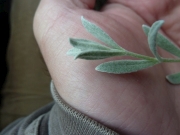
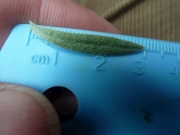
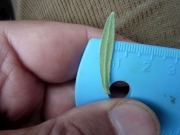
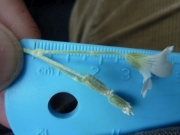
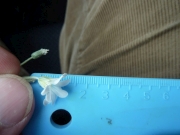
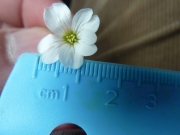
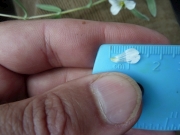
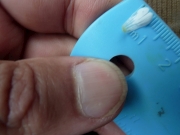
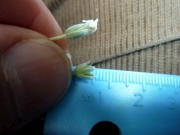
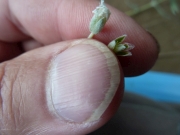
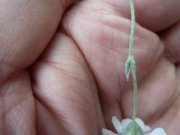

 I recognized the pea flowers right away and went to the Fabaceae (Pea Family) key
to find out the genus of this plant. Fortunately, I was able to skip over much
of the Fabaceae key due to this plant having leaves with three leaflets that are
toothed.
I recognized the pea flowers right away and went to the Fabaceae (Pea Family) key
to find out the genus of this plant. Fortunately, I was able to skip over much
of the Fabaceae key due to this plant having leaves with three leaflets that are
toothed.

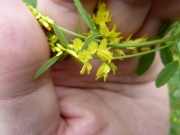
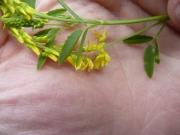


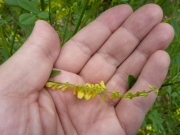
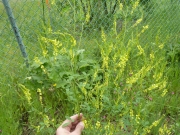
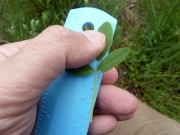

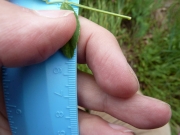
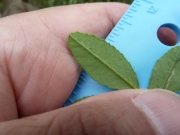
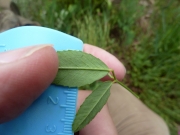
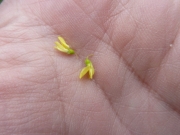
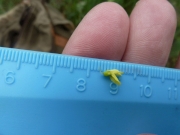
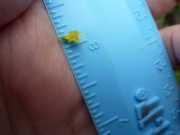
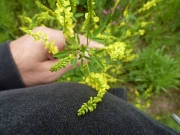
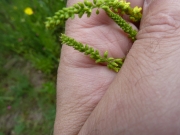
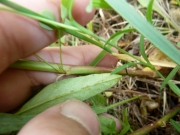
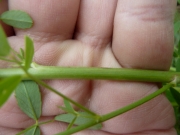

 I have been trying to figure out this plant since last year. I can recognize pea
family flowers more easily, so I just had to figure out the genus and species:
I have been trying to figure out this plant since last year. I can recognize pea
family flowers more easily, so I just had to figure out the genus and species:

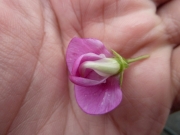
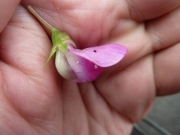
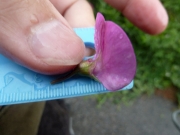
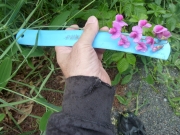
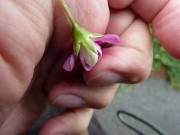
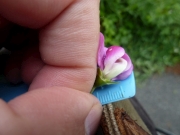
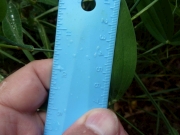
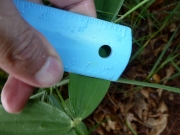
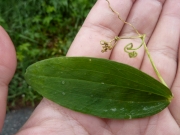
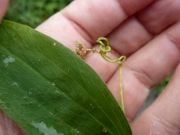
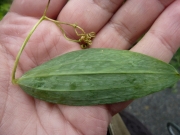
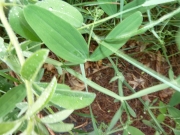
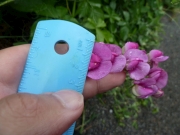
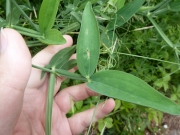
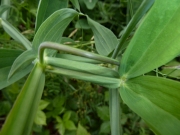
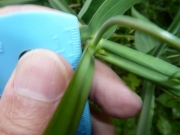

 I thought I found this plant last May, but there was no easy way at that time
to differentiate Whorled Bedstraw (Galium mollugo) from White Bedstraw
(Galium album). So, I am replacing those pictures with these which are
definately Galium mollugo.
I thought I found this plant last May, but there was no easy way at that time
to differentiate Whorled Bedstraw (Galium mollugo) from White Bedstraw
(Galium album). So, I am replacing those pictures with these which are
definately Galium mollugo.

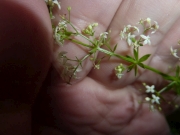
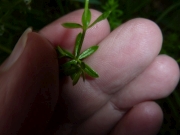
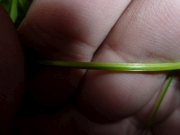
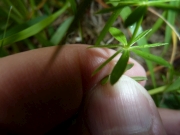
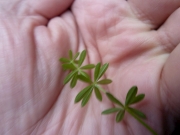
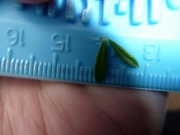
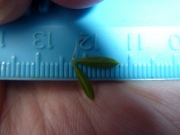
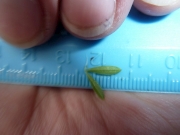
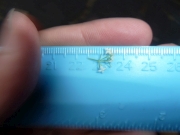
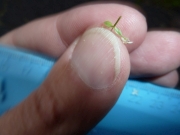
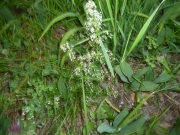

 I identified another tree! Fortunately, the leaf shape is very distinctive. The buds
are supposed to be hairy, but I only found a few stray hairs on each of the buds.
I identified another tree! Fortunately, the leaf shape is very distinctive. The buds
are supposed to be hairy, but I only found a few stray hairs on each of the buds.

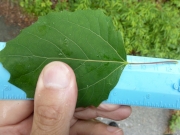
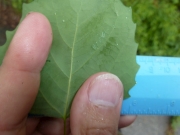
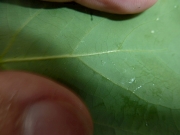
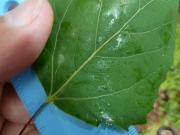
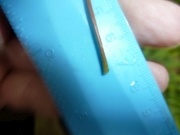
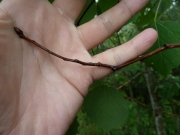
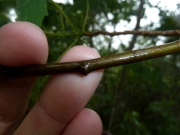
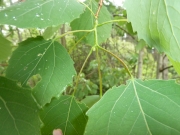
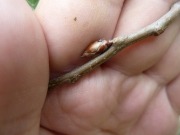
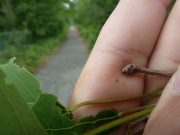
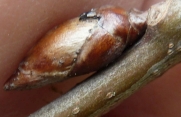

 I really love the taste of the tops of Virginia Pepperweed. Mustard-like, tangy taste.
There were hundreds upon hundreds of plants. I could gather the flower tops, dry and
grind them into a powder to spice up dishes! Hiked and snacked on Virginia Papperweed,
Canada Lettuce, Hoary Allysum, Tower Mustard, and Indian Cucumber.
I really love the taste of the tops of Virginia Pepperweed. Mustard-like, tangy taste.
There were hundreds upon hundreds of plants. I could gather the flower tops, dry and
grind them into a powder to spice up dishes! Hiked and snacked on Virginia Papperweed,
Canada Lettuce, Hoary Allysum, Tower Mustard, and Indian Cucumber.

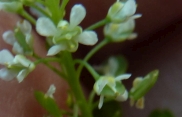
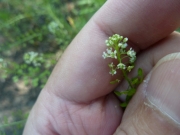
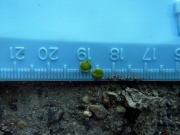
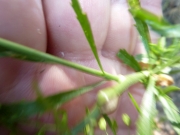
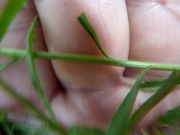
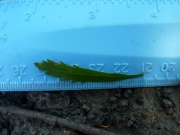
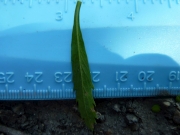
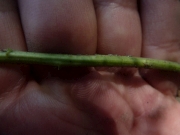

 Big patches of this plant was growing in the dirt (near grass). It grew tangled and
very low to the ground. I didn't get any pictures at that location, but picked some
and took pictures while holding it on the final leg of my hike. I didn't realize,
but there is an Annual Knawel (this plant) and a Perennial Knawel
(Scleranthus perennis). The Perennial Knawel has sepals that are obtouse to
rounded at the apex and the floral bracts are mostly shorter than the flowers.
The Annual Knawel has acute-tipped sepals and bracts equaling or exceeding the
flowers.
Big patches of this plant was growing in the dirt (near grass). It grew tangled and
very low to the ground. I didn't get any pictures at that location, but picked some
and took pictures while holding it on the final leg of my hike. I didn't realize,
but there is an Annual Knawel (this plant) and a Perennial Knawel
(Scleranthus perennis). The Perennial Knawel has sepals that are obtouse to
rounded at the apex and the floral bracts are mostly shorter than the flowers.
The Annual Knawel has acute-tipped sepals and bracts equaling or exceeding the
flowers.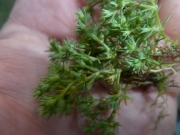
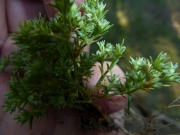
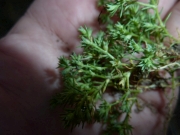

 This is my third Rubus species identification. There are a total of 28 species
in New England. Key:
This is my third Rubus species identification. There are a total of 28 species
in New England. Key:

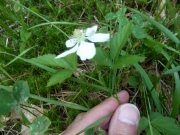
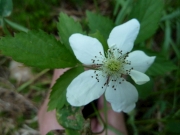
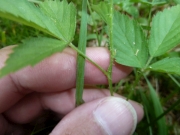
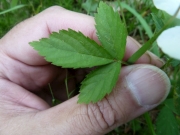
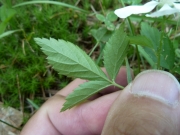
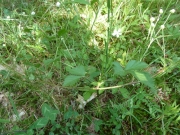
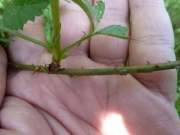
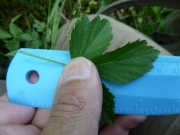
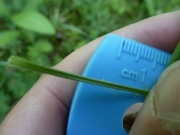
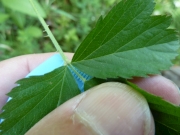
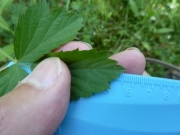
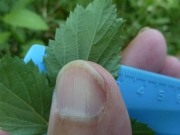
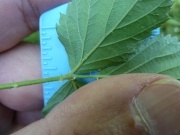
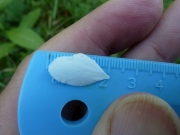
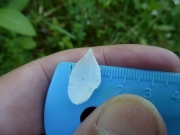
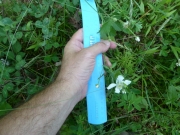

 This is commonly seen as a very young tree in the forest. But this one was a bit
older so I could be sure that it grows into a full-sized maple tree. It has very
big leaves and each lobe comes to a sharp point. There are many small teeth in
between each lobe.
This is commonly seen as a very young tree in the forest. But this one was a bit
older so I could be sure that it grows into a full-sized maple tree. It has very
big leaves and each lobe comes to a sharp point. There are many small teeth in
between each lobe.

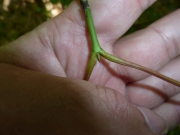
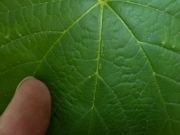
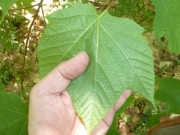
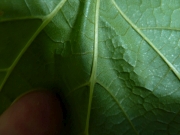
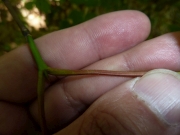
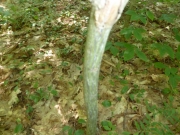
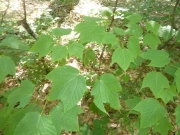
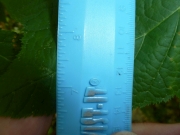
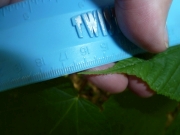
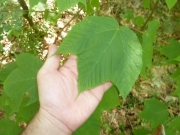
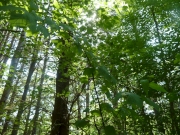

 Last year I found a Blue-Eyed Grass and when I went back out to identify the species, the
rain had washed away all of the flowers. There are two important pieces of information
to determining the species: 1) the long bract (spathe) below the flower will either be
sessile or borne on a flower stem (peduncle). If it is borne on a flower stem, there will
usually be 2-5 peduncles per stem; 2) The stems will either have obvious winged margins
or barely-discernable wingled margins.
Last year I found a Blue-Eyed Grass and when I went back out to identify the species, the
rain had washed away all of the flowers. There are two important pieces of information
to determining the species: 1) the long bract (spathe) below the flower will either be
sessile or borne on a flower stem (peduncle). If it is borne on a flower stem, there will
usually be 2-5 peduncles per stem; 2) The stems will either have obvious winged margins
or barely-discernable wingled margins.
 Key:
Key:
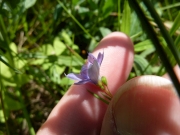
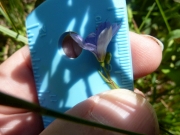
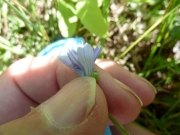
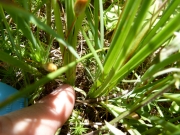
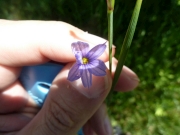
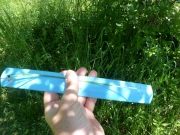
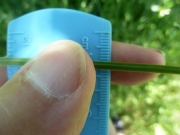
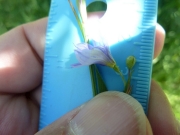
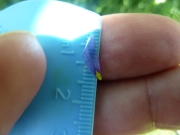
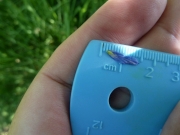
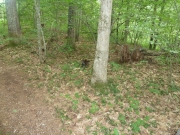
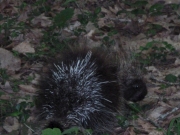
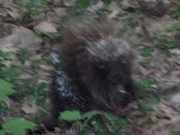
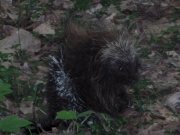

 I love ferns (and plants) that are easy to identify! Remember that
Cinnamon Fern (Osmunda cinnamomea) has a separate fertile frond (leaf) with
cinnamon-colored spore-bearing leaflets completely covering the leaf blade. In
the case of Interrupted fern, the fertile fronds have regular leaflets that
are interrupted by several sets of dark brown spore-bearing leaflets. The slightly
shorter sterile fronds have no spore-bearing leaflets. The first picture to the
right shows a fertile frond with three sets of dark brown spore-bearing leaflets.
I love ferns (and plants) that are easy to identify! Remember that
Cinnamon Fern (Osmunda cinnamomea) has a separate fertile frond (leaf) with
cinnamon-colored spore-bearing leaflets completely covering the leaf blade. In
the case of Interrupted fern, the fertile fronds have regular leaflets that
are interrupted by several sets of dark brown spore-bearing leaflets. The slightly
shorter sterile fronds have no spore-bearing leaflets. The first picture to the
right shows a fertile frond with three sets of dark brown spore-bearing leaflets.
 The fronds are large and grow in a circle. The leaf stalk (stipe) has tan wooly hairs.
The fiddleheads are stout with white to light tan wooly hairs. The leaves are bipinnate.
Royal Fern (Osmunda regalis) is similar to Interrupted Fern except the
spore-bearing leaflets are produced at the apex of the leaf blade.
The fronds are large and grow in a circle. The leaf stalk (stipe) has tan wooly hairs.
The fiddleheads are stout with white to light tan wooly hairs. The leaves are bipinnate.
Royal Fern (Osmunda regalis) is similar to Interrupted Fern except the
spore-bearing leaflets are produced at the apex of the leaf blade.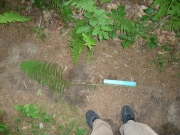
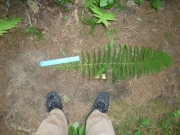
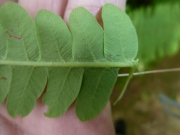
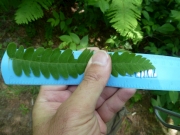
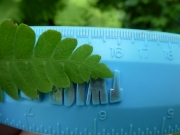

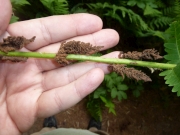
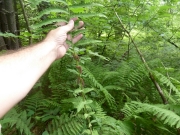
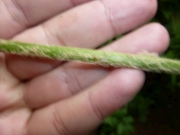
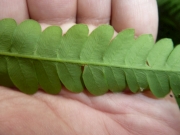
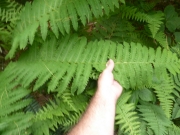
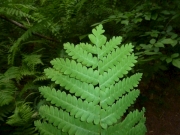

 The smell from crushed Eastern Hay-Scented Fern is supposed to be like freshly cut hay,
but I do not remember what that smell is like. This plant (when crushed) smells a
little like Sweet Fern (Comptonia peregrina). Keys to identifying this fern:
The smell from crushed Eastern Hay-Scented Fern is supposed to be like freshly cut hay,
but I do not remember what that smell is like. This plant (when crushed) smells a
little like Sweet Fern (Comptonia peregrina). Keys to identifying this fern:

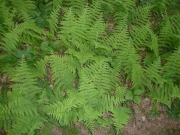
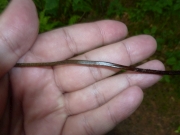
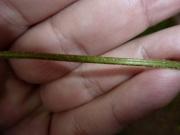
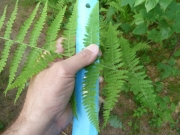
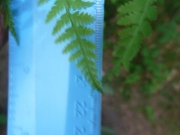
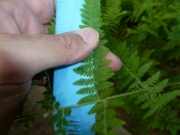
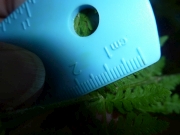
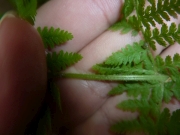
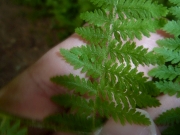
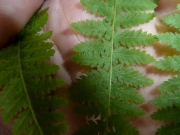
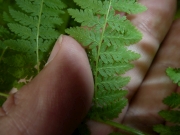
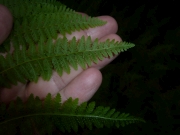
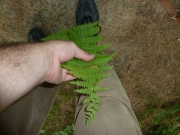
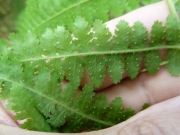
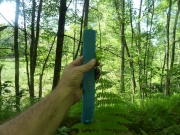

 This is supposed to be the only large fern (up to 3 ft. tall) in New England
where the blade is divided into three segments. The two basal pinnae are
relatively large. The blade is often held parallel to the ground. The stipe is
smooth and grooved. Sori are silvery at first, turning brown later in the year. The
sori are often covered or partially covered by the reflexed margins of the pinnules.
This is supposed to be the only large fern (up to 3 ft. tall) in New England
where the blade is divided into three segments. The two basal pinnae are
relatively large. The blade is often held parallel to the ground. The stipe is
smooth and grooved. Sori are silvery at first, turning brown later in the year. The
sori are often covered or partially covered by the reflexed margins of the pinnules.
 Key:
Key:
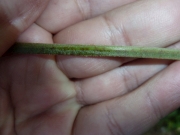
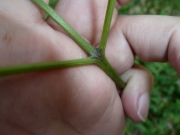

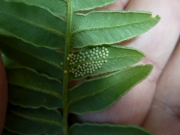
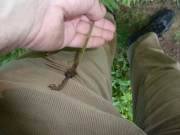
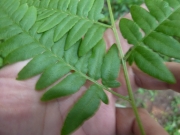
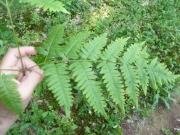
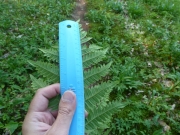
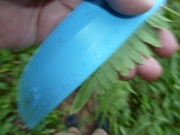
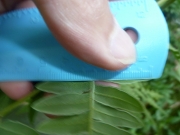
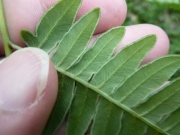
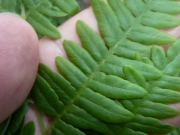

 This was my first difficult fern as far as the ID. The important thing to look for
is the sori are long and almost straight, but often with a slight curve. The fronds
grow in circular clusters and have a relaxed (hanging down) tip. The stipe is smooth
with scattered brown scales. Base of stipe dark red-brown and swollen. Blade widest
in the middle.
This was my first difficult fern as far as the ID. The important thing to look for
is the sori are long and almost straight, but often with a slight curve. The fronds
grow in circular clusters and have a relaxed (hanging down) tip. The stipe is smooth
with scattered brown scales. Base of stipe dark red-brown and swollen. Blade widest
in the middle.

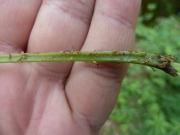
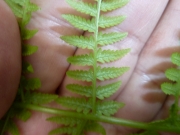
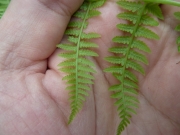
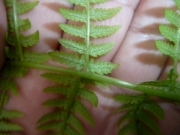
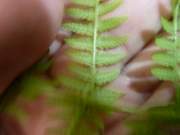
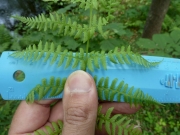
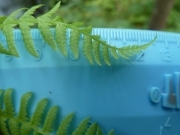
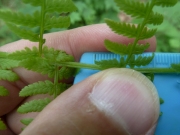
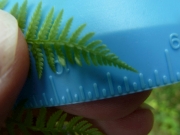

 After a couple of years of hoping to find this tree, I found it. Actually, someone else
pointed it out to me. Hopefully, I can find many more and be ready for Springtime leaf
snacks. A few things I want to remember include:
After a couple of years of hoping to find this tree, I found it. Actually, someone else
pointed it out to me. Hopefully, I can find many more and be ready for Springtime leaf
snacks. A few things I want to remember include:

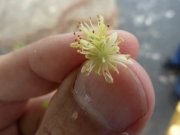
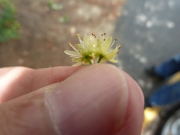
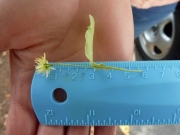
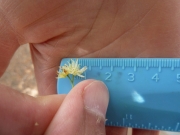
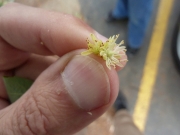
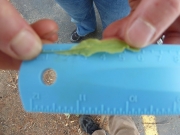
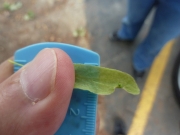
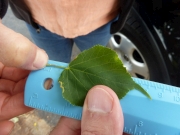
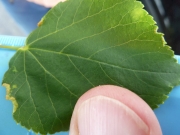
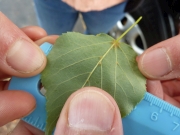
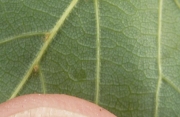
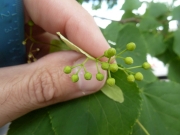
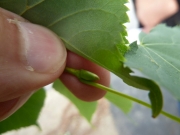
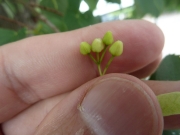
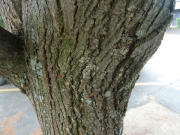
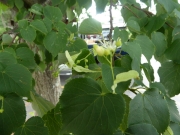
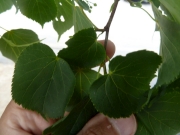
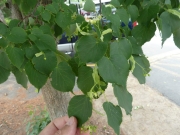
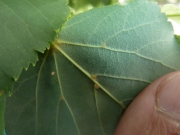
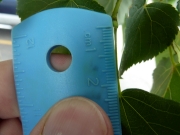
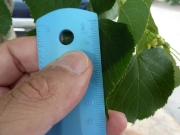

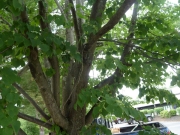

 When I saw the flowers, I immediately thought of cinquefoil flowers. But the leaves looked
so much different. So, I went through the key of the Rosaceae family to discover that it
was the Dasiphora genus. Key:
When I saw the flowers, I immediately thought of cinquefoil flowers. But the leaves looked
so much different. So, I went through the key of the Rosaceae family to discover that it
was the Dasiphora genus. Key:


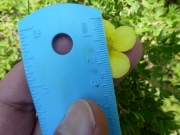
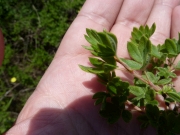
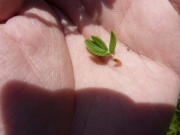
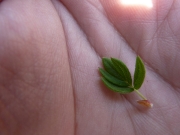
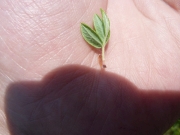
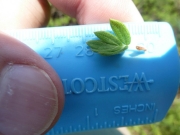
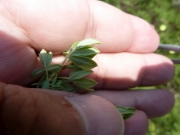
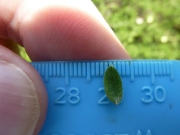
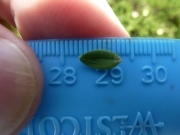
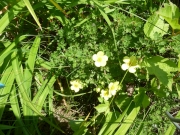
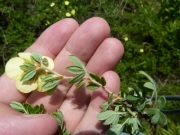
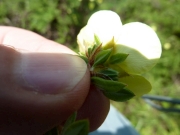
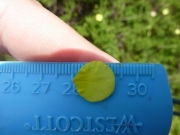
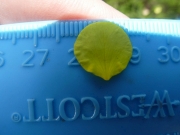
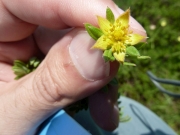
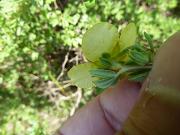

 I saw this plant last year and thought it might be an Aster. But few Asters are in bloom
now. Fortunately, the leaves with three toothed leaflets below and simple leaves above
helped me identify this plant.
I saw this plant last year and thought it might be an Aster. But few Asters are in bloom
now. Fortunately, the leaves with three toothed leaflets below and simple leaves above
helped me identify this plant.
 Key:
Key:
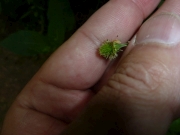
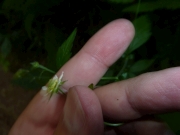
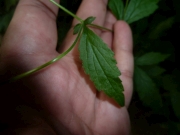
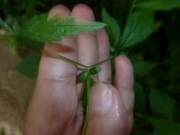
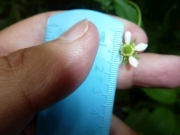
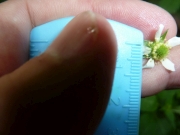
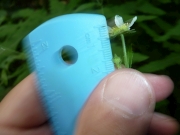
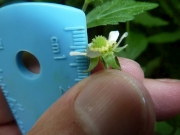
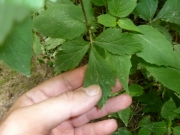
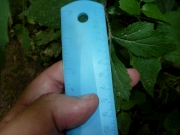
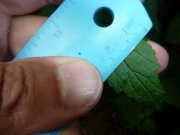

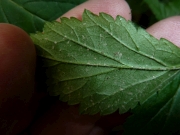
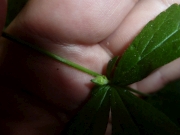
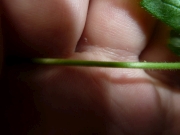

 I’ve seen a lot of Blackberry bushes lately, but they don’t always have
flowers or blackberries growing, so they have been difficult to identify. This one
has both blackberries (still green) and flower remnants. Some of the important things
to look for are straightish spines on the primocane, stipitate glands or gland-tipped
hairs on the peduncle, raceme inflorescence longer than 8 mm. Key:
I’ve seen a lot of Blackberry bushes lately, but they don’t always have
flowers or blackberries growing, so they have been difficult to identify. This one
has both blackberries (still green) and flower remnants. Some of the important things
to look for are straightish spines on the primocane, stipitate glands or gland-tipped
hairs on the peduncle, raceme inflorescence longer than 8 mm. Key:

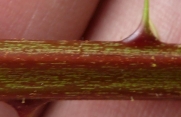
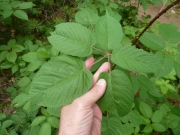
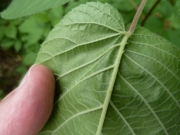
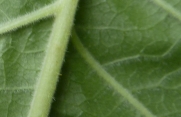
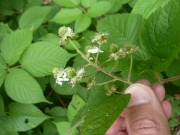
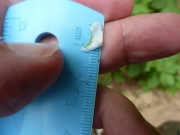
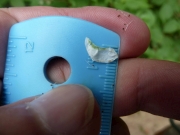
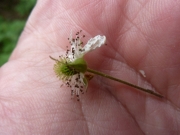

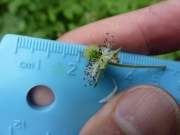
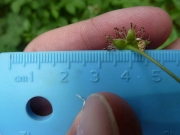
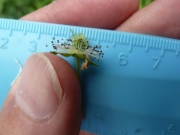
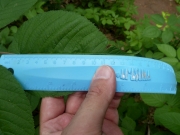
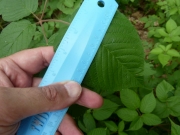
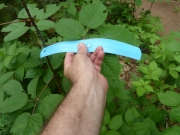
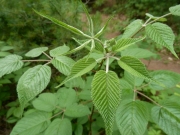
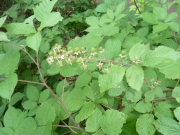
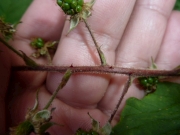

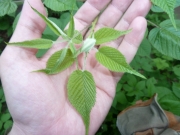
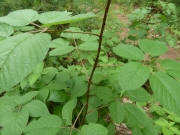
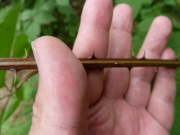

 This was an unexpected encounter. After several years of walking along trails, I have
only seen a Shinleaf one other time. It was right at the edge of the trail in a fairly
dry location amongst American Beech trees. Key:
This was an unexpected encounter. After several years of walking along trails, I have
only seen a Shinleaf one other time. It was right at the edge of the trail in a fairly
dry location amongst American Beech trees. Key:

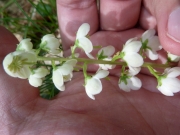
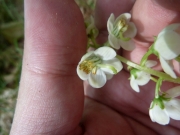
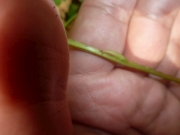
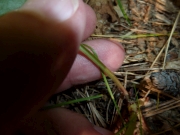
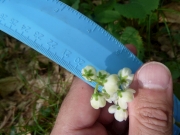
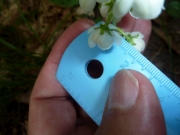
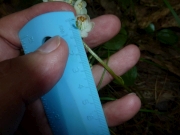
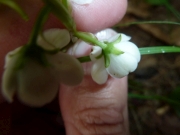
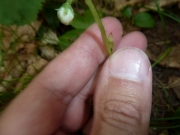
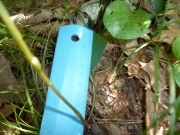
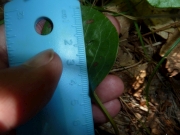
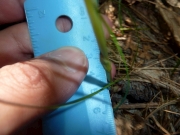
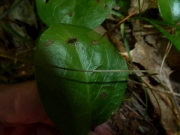
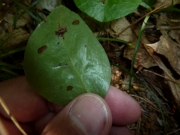


 I wonder why this is named, “Maleberry.” Finding out sounds like a good Winter project.
It is important to remember to take pictures of the brown five-parted seed capsules as it is a
tell-tale sign of Maleberry (See the picture in the second row on the left.) A few things about
this plant to notice:
I wonder why this is named, “Maleberry.” Finding out sounds like a good Winter project.
It is important to remember to take pictures of the brown five-parted seed capsules as it is a
tell-tale sign of Maleberry (See the picture in the second row on the left.) A few things about
this plant to notice:

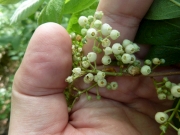
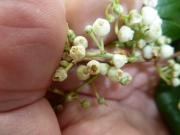
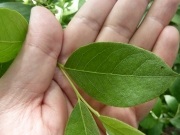
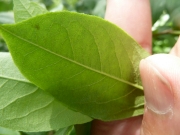
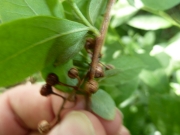
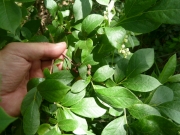
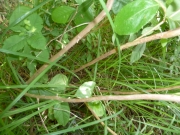
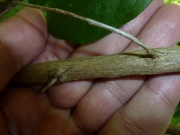
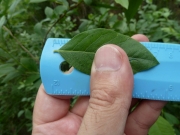
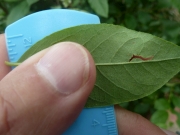
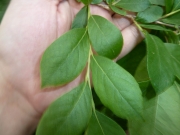
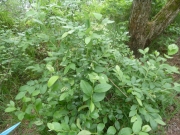
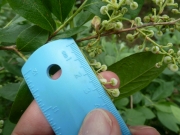
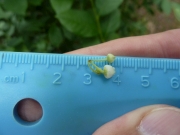
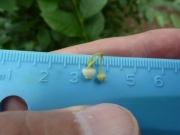
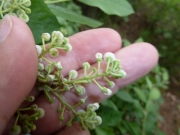

 This fern is similar to Cinnamon Fern (Osmunda cinnamomea) and Interrupted Fern
(Osmunda claytoniana). Cinnamon Fern has a complete separate cinnamon-colored
stalk of spores. Interrupted Fern has fertile frond leaflets (pinnae) and then spores
in the middle followed by more leaflets. Royal fern has spores covering the tops of the
fertile frond. Another difference is the Royal Fern has much longer and wider-space
(alternating) pinnules (leafules). It is often found next to water.
This fern is similar to Cinnamon Fern (Osmunda cinnamomea) and Interrupted Fern
(Osmunda claytoniana). Cinnamon Fern has a complete separate cinnamon-colored
stalk of spores. Interrupted Fern has fertile frond leaflets (pinnae) and then spores
in the middle followed by more leaflets. Royal fern has spores covering the tops of the
fertile frond. Another difference is the Royal Fern has much longer and wider-space
(alternating) pinnules (leafules). It is often found next to water.

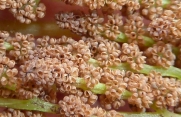
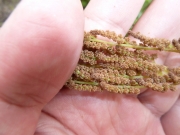
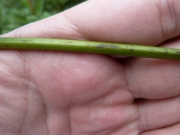
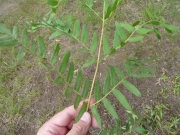
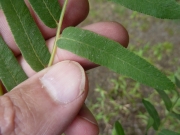

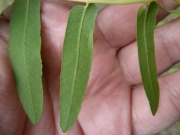
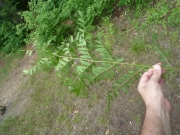
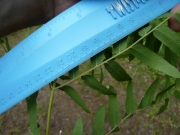
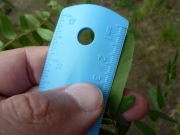
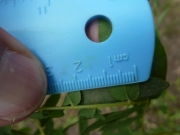
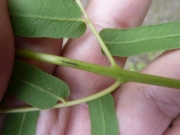
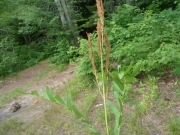
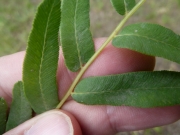
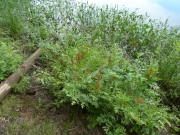

 This plant may have escaped from a garden somewhere. It is easy to see that the flowers
look similar to Maiden Pink (Dianthus deltoides). Key:
This plant may have escaped from a garden somewhere. It is easy to see that the flowers
look similar to Maiden Pink (Dianthus deltoides). Key:

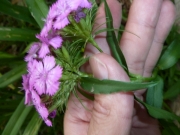
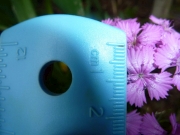
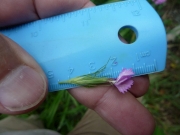
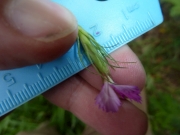
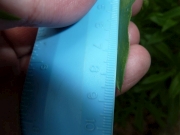
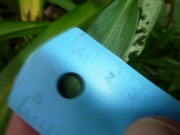
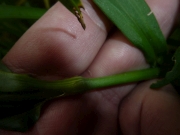
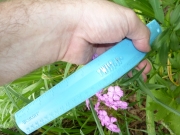

 A few important tips for recognizing Marginal Wood Fern:
A few important tips for recognizing Marginal Wood Fern:


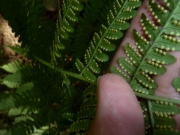
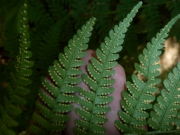

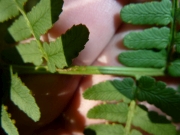
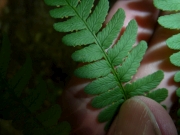
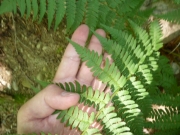
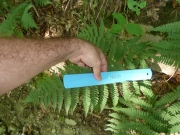
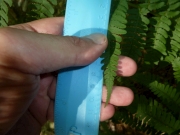
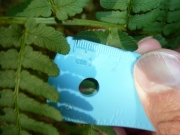
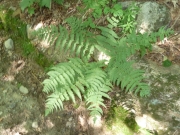
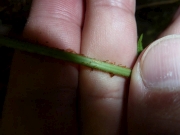

 What an amazing find! Actually, Arthur Haines found this before it flowered while
he was teaching a class. When I was back in the area, I looked to see what it had turned
into. At first I wasn’t sure that it was a Evening Primrose genus (Oenothera),
so I went through the Onagraceae (Evening Primrose family) key:
What an amazing find! Actually, Arthur Haines found this before it flowered while
he was teaching a class. When I was back in the area, I looked to see what it had turned
into. At first I wasn’t sure that it was a Evening Primrose genus (Oenothera),
so I went through the Onagraceae (Evening Primrose family) key:
 the flower. I was told by
Arthur Haines to also notice that the stamen in this case are oriented toward one side of the
flower. Genus: Oenothera
the flower. I was told by
Arthur Haines to also notice that the stamen in this case are oriented toward one side of the
flower. Genus: Oenothera
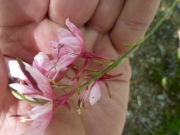
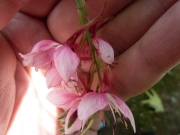
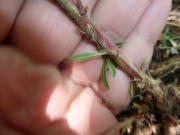
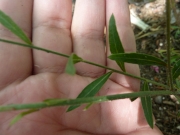
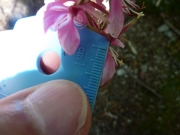
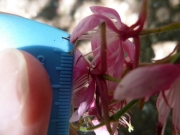
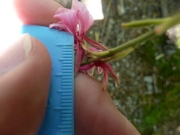
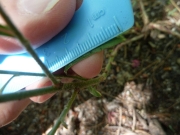
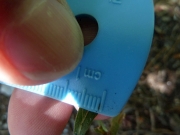
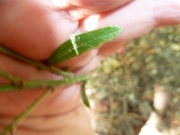
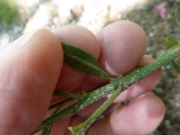
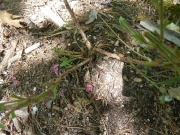

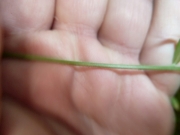
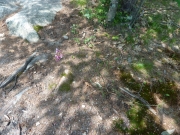
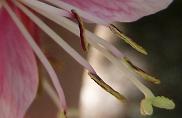
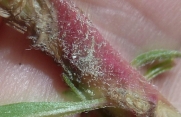
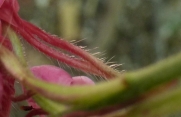
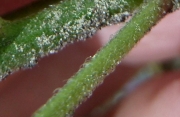
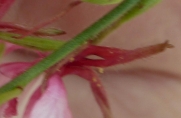
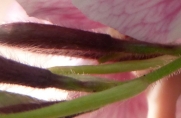
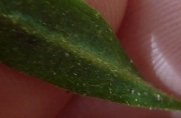


 Out of the 16 white, pink or purple Trifolium flowers in New England, only
White Clover and Alsike Clover (Trifolium hybridum) have flower pedicels
longer than 0.5 mm (usually 2 mm or longer). To differentiate these two plants:
Out of the 16 white, pink or purple Trifolium flowers in New England, only
White Clover and Alsike Clover (Trifolium hybridum) have flower pedicels
longer than 0.5 mm (usually 2 mm or longer). To differentiate these two plants:

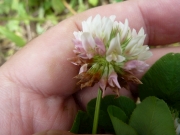
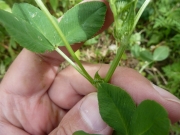
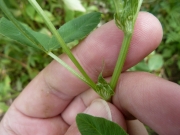
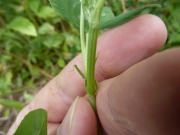
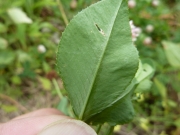
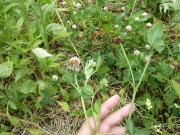
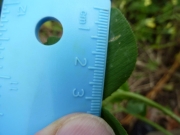
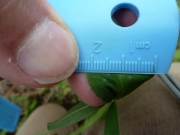
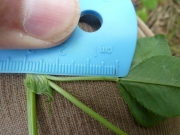
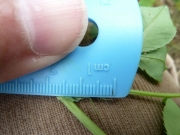
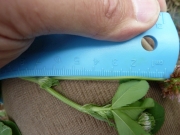
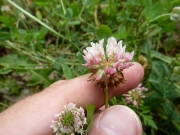
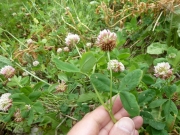
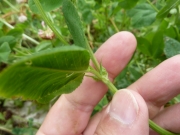

 This is a common weed in the public gardens. It is extremely hairy and edible (cooked).
The easiest way to differentiate it from Lesser Quickweed (Galinsoga parviflora) is
that Lesser Quickweed is much less hairy. In addition, the pappus (modified calyx crowning the
ovary) of the disk flowers for Hairy Galinsoga has an awn (narrow bristle) tip. The pappus
of the ray flowers of Hairy Galinsoga is well-developed, but poorly-developed for
Lesser Quickweed.
This is a common weed in the public gardens. It is extremely hairy and edible (cooked).
The easiest way to differentiate it from Lesser Quickweed (Galinsoga parviflora) is
that Lesser Quickweed is much less hairy. In addition, the pappus (modified calyx crowning the
ovary) of the disk flowers for Hairy Galinsoga has an awn (narrow bristle) tip. The pappus
of the ray flowers of Hairy Galinsoga is well-developed, but poorly-developed for
Lesser Quickweed.

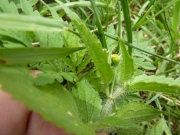
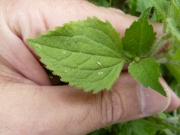
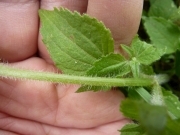
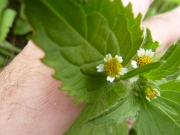
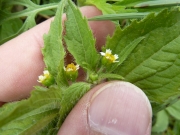
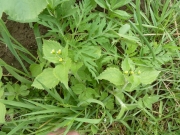

 New Jersey Tea (Ceanothus americanus) is part of the Buckthorn (Rhamnaceae) family.
What distinguishes the Ceanothus genus from other Buckthorn genuses is that the leaf blade
has three prominent veins from near the base of the leaf and the inflorescense is a terminal umbrel
with numerous flowers. Prairie Redroot (Ceanothus herbaceus) is similar, but New Jersey Tea
has larger leaves and the veins emerge from 1-3 mm below the base of the leaf.
New Jersey Tea (Ceanothus americanus) is part of the Buckthorn (Rhamnaceae) family.
What distinguishes the Ceanothus genus from other Buckthorn genuses is that the leaf blade
has three prominent veins from near the base of the leaf and the inflorescense is a terminal umbrel
with numerous flowers. Prairie Redroot (Ceanothus herbaceus) is similar, but New Jersey Tea
has larger leaves and the veins emerge from 1-3 mm below the base of the leaf.

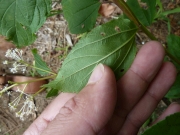
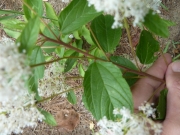
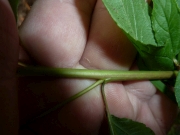
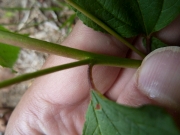
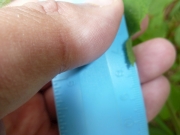
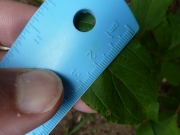
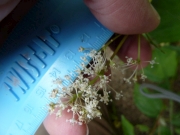


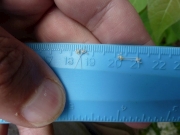
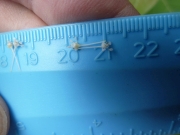
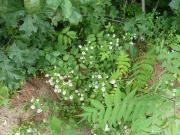

 This is a fairly common plant. But I had avoided trying to identify it for years
because I never saw the flowers. There is only one species in the Boehmeria genus
(in New England). But there is another genus in the same family with very similar,
non-stinging plants: Pilea. The flowers of Small-Spike False Nettle are a spike,
while the flowers of Pilea species are a panicle. In addition, the cystoliths
(concentration of calcium carbonate appearing as minute segments on the leaf) are rounded
in Small-Spike False Nettle but linear in Pilea species.
This is a fairly common plant. But I had avoided trying to identify it for years
because I never saw the flowers. There is only one species in the Boehmeria genus
(in New England). But there is another genus in the same family with very similar,
non-stinging plants: Pilea. The flowers of Small-Spike False Nettle are a spike,
while the flowers of Pilea species are a panicle. In addition, the cystoliths
(concentration of calcium carbonate appearing as minute segments on the leaf) are rounded
in Small-Spike False Nettle but linear in Pilea species.

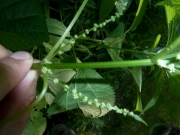
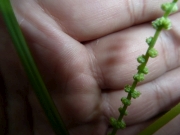
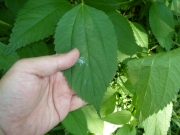
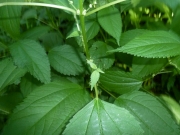
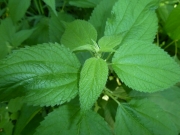

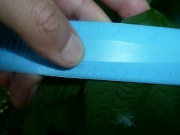
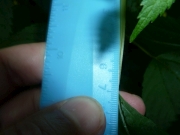
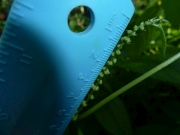
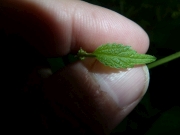
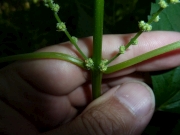
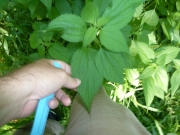

 At first I thought this was White Bedstraw (Galium album). I didn’t
want to hang around for photos because the mosquitoes were swarming. Fortuntely,
I noticed that the stem was very sticky (and rough) feeling. I'll need to go back
and double-check, tough.
At first I thought this was White Bedstraw (Galium album). I didn’t
want to hang around for photos because the mosquitoes were swarming. Fortuntely,
I noticed that the stem was very sticky (and rough) feeling. I'll need to go back
and double-check, tough.
 with 5-20 flowers. This plant seems to have inflorescences with 2-3 flowers. Key:
with 5-20 flowers. This plant seems to have inflorescences with 2-3 flowers. Key: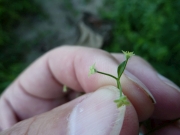
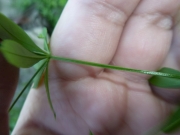
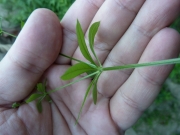
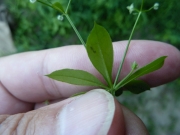
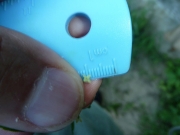
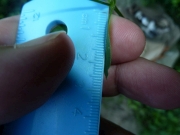
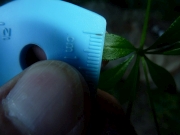


 I had a hard time determining if this was White Mulberry (Morus alba)
or Red Mulberry (Morus rubra) since it seems to have some characteristics
of both. The front of the leaves were scabrous (rough to touch due to short,
stiff, appressed hairs) as found in Red Mulberry, but it was only slightly scabrouns
and slightly smooth. The front leaf surface was glossy as found in White Mulberry. The
back of the leaf had tufts of hairs along the major veins as found in White Mulberry.
I had a hard time determining if this was White Mulberry (Morus alba)
or Red Mulberry (Morus rubra) since it seems to have some characteristics
of both. The front of the leaves were scabrous (rough to touch due to short,
stiff, appressed hairs) as found in Red Mulberry, but it was only slightly scabrouns
and slightly smooth. The front leaf surface was glossy as found in White Mulberry. The
back of the leaf had tufts of hairs along the major veins as found in White Mulberry.
 Some of the fruit was whitish as found in White Mulberry (although it will be interesting
to see if those whitish fruits turn purple. White Mulberry can have some fruits
that are pink, purple and even black. Finally, red Mulberry is found mostly in Western
New England while White Mulberry throughout New England.
Some of the fruit was whitish as found in White Mulberry (although it will be interesting
to see if those whitish fruits turn purple. White Mulberry can have some fruits
that are pink, purple and even black. Finally, red Mulberry is found mostly in Western
New England while White Mulberry throughout New England.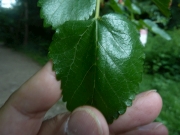
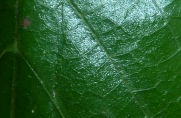
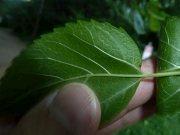
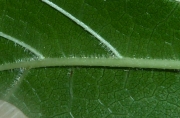

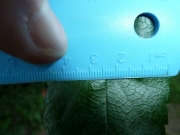
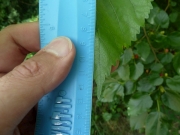
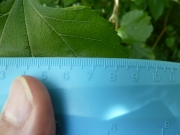
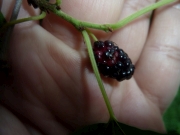
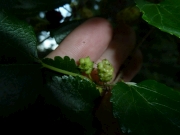
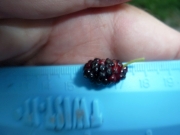
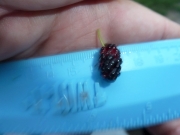
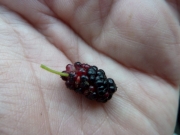
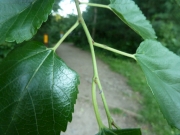
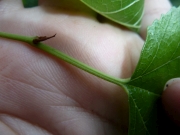
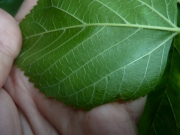
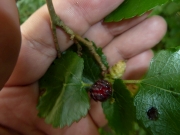
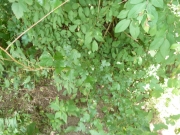
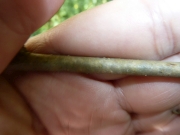

 Out of the 16 white, pink or purple Trifolium flowers in New England, only
White Clover and Alsike Clover (Trifolium hybridum) have flower pedicels
longer than 0.5 mm (usually 2 mm or longer). To differentiate these two plants:
Out of the 16 white, pink or purple Trifolium flowers in New England, only
White Clover and Alsike Clover (Trifolium hybridum) have flower pedicels
longer than 0.5 mm (usually 2 mm or longer). To differentiate these two plants:

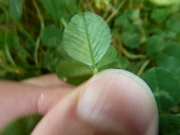
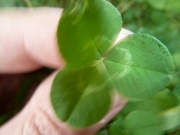
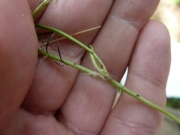
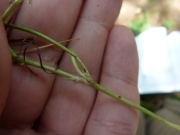
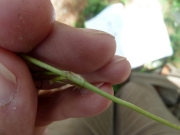
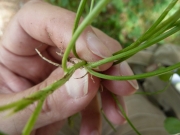

 Finally! It took me forever to find this fern! But I'll be enjoying fiddleheads next
Spring. Here are a couple of key identifying features:
Finally! It took me forever to find this fern! But I'll be enjoying fiddleheads next
Spring. Here are a couple of key identifying features:
 Spring. See pictures near the
bottom of the table for images of an dead fertile frond.
Spring. See pictures near the
bottom of the table for images of an dead fertile frond.
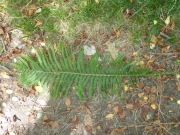
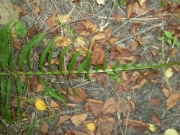
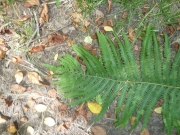
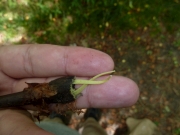
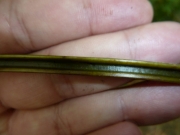
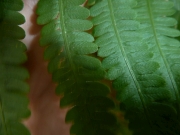

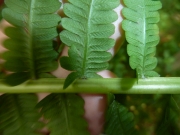
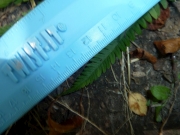
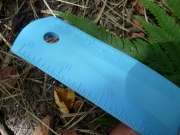
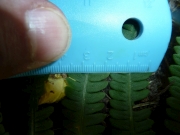
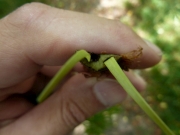
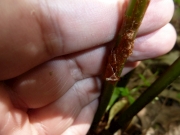
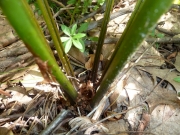
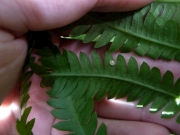
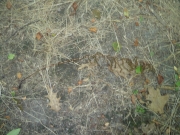
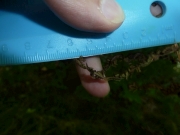
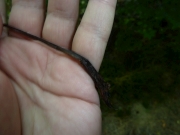
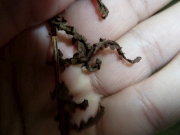
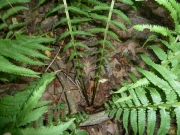

 I found this fern in May 2011 in fiddlehead form, but I wasn't able to identify it.
A research botanist told me at the time that it was Evergreen Wood Fern. The is my
first real identification of the plant (at a new location). Here are a few things
to remember about Evergreen Wood Fern:
I found this fern in May 2011 in fiddlehead form, but I wasn't able to identify it.
A research botanist told me at the time that it was Evergreen Wood Fern. The is my
first real identification of the plant (at a new location). Here are a few things
to remember about Evergreen Wood Fern:

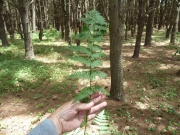


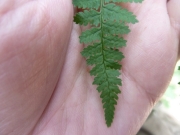
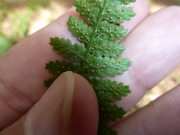
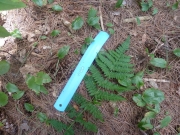
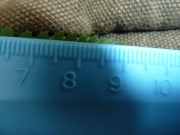
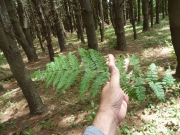
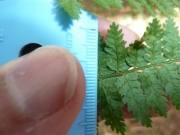
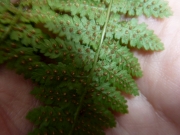
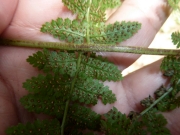
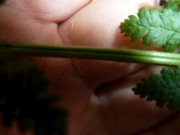
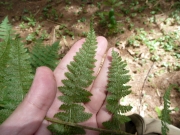
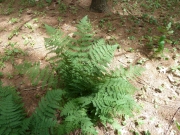
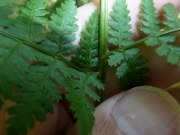

 The silique seed pods were a give-away that this was in the Mustard family. It
has a very nice horseradish taste. Key:
The silique seed pods were a give-away that this was in the Mustard family. It
has a very nice horseradish taste. Key:

